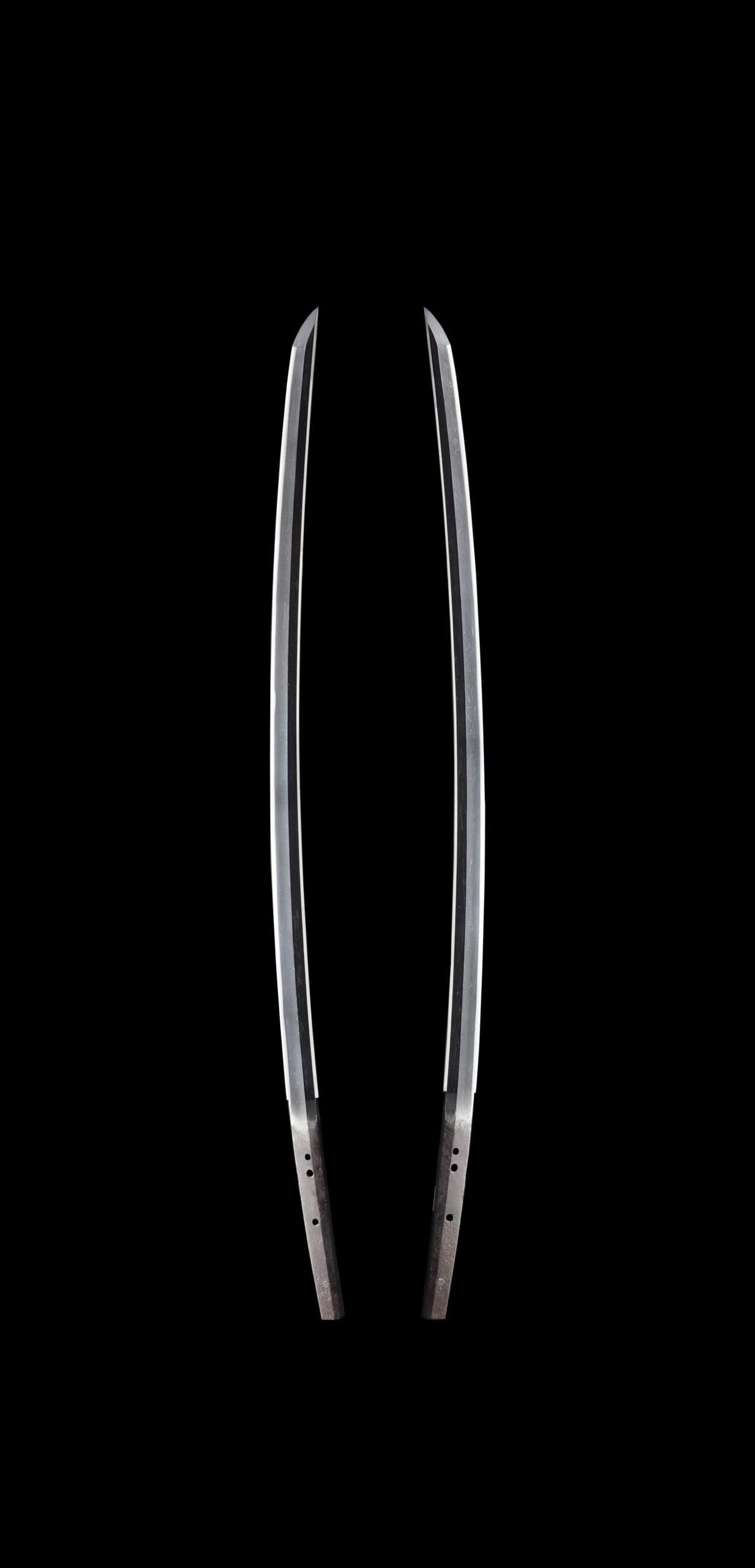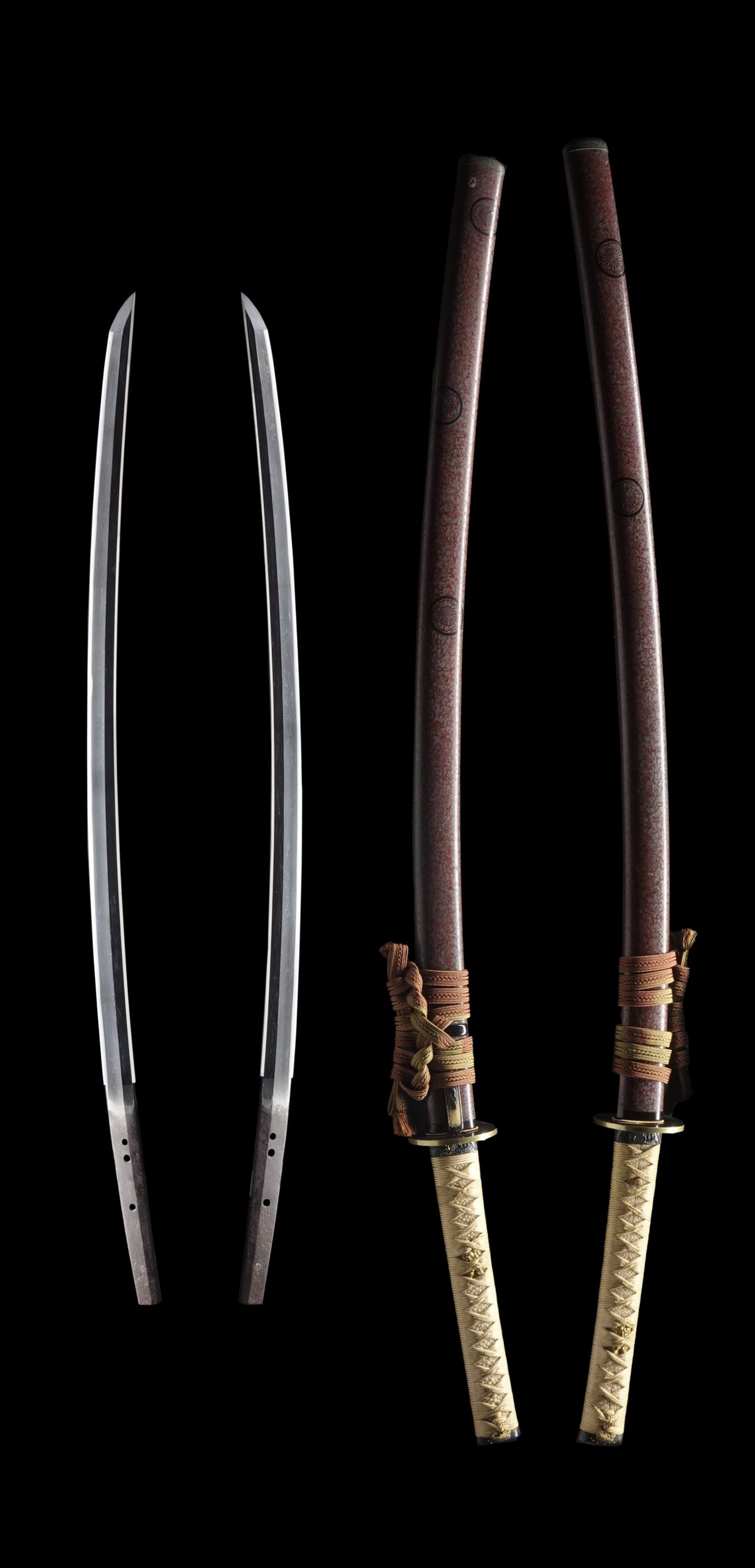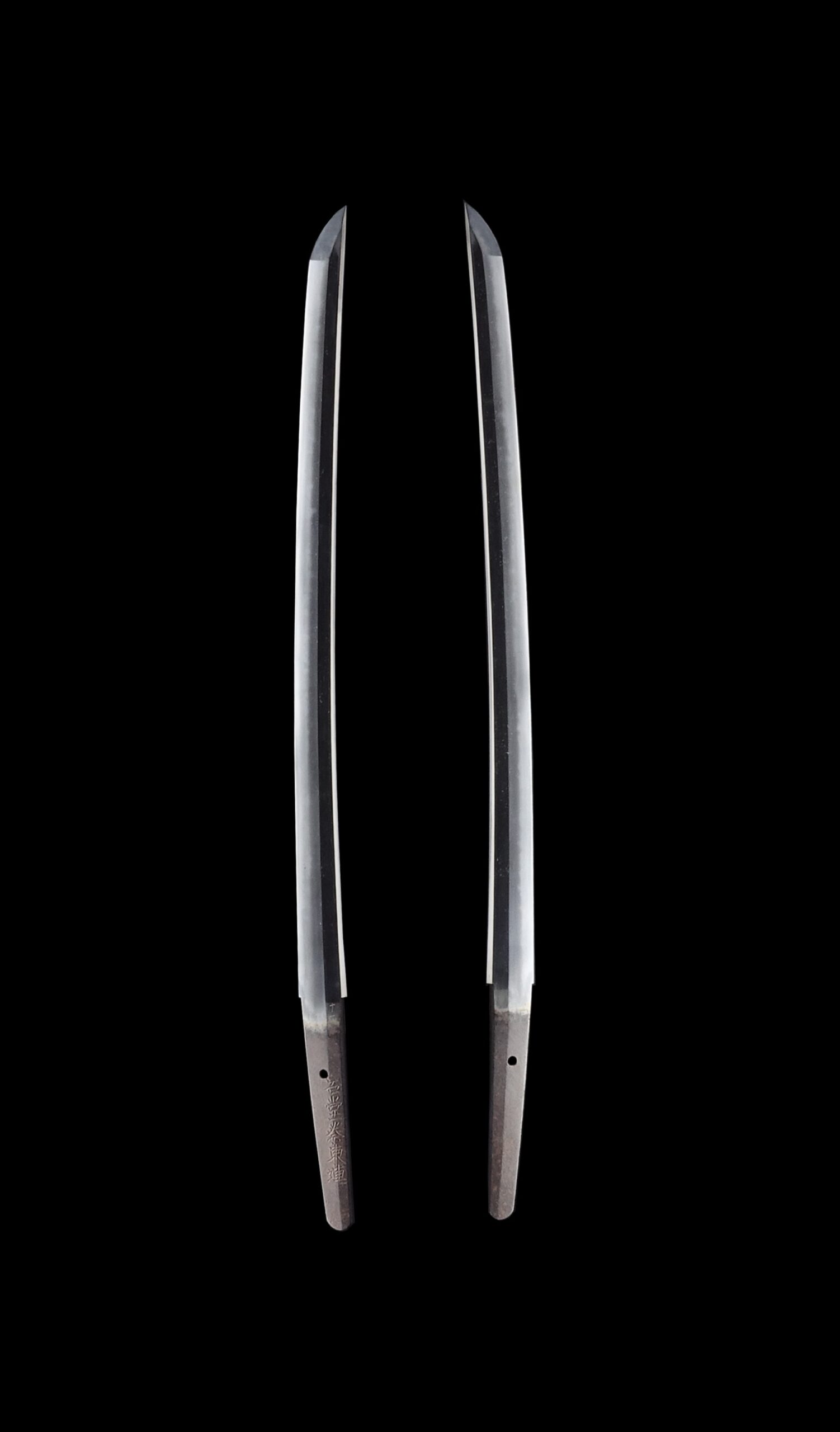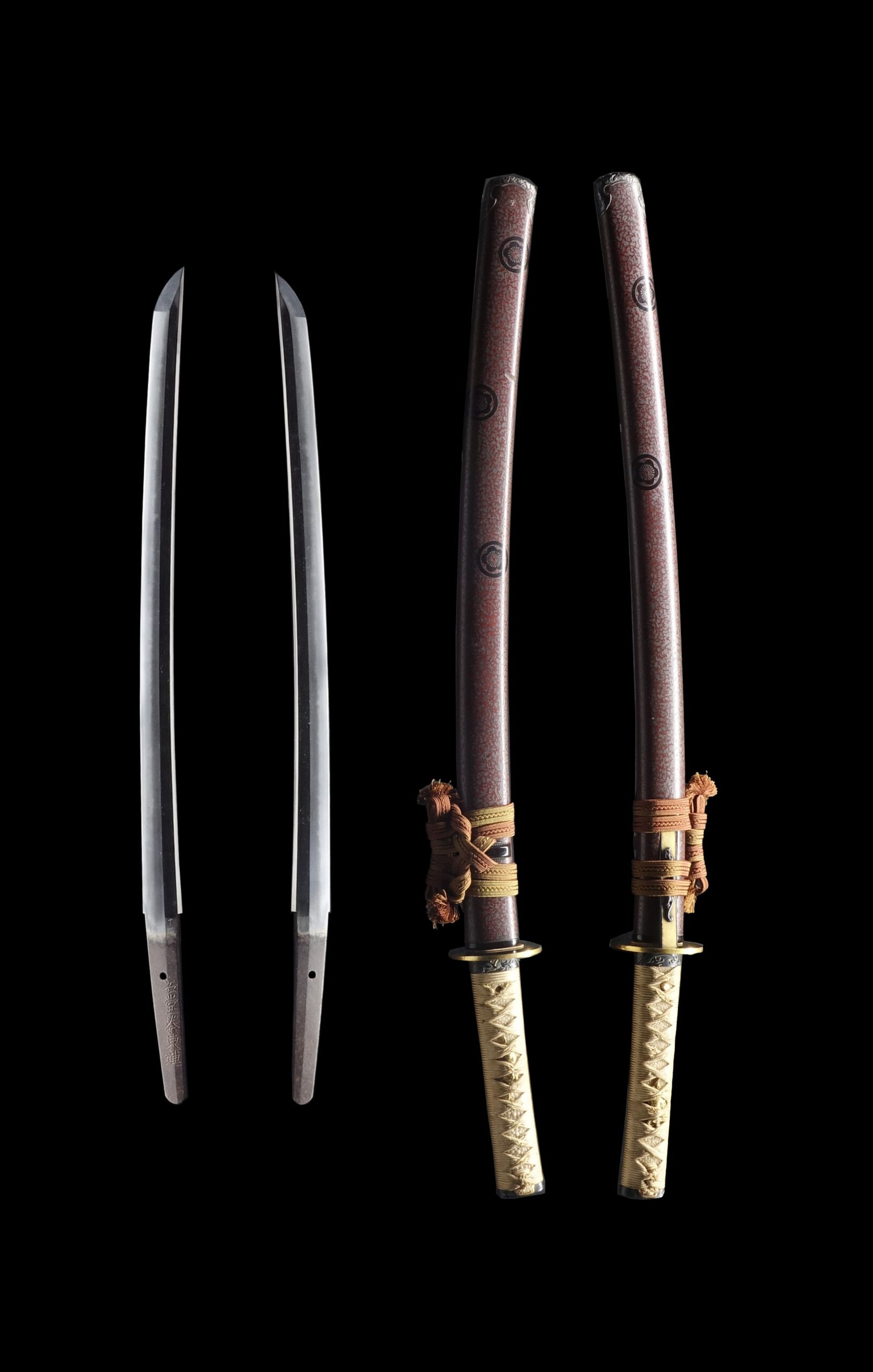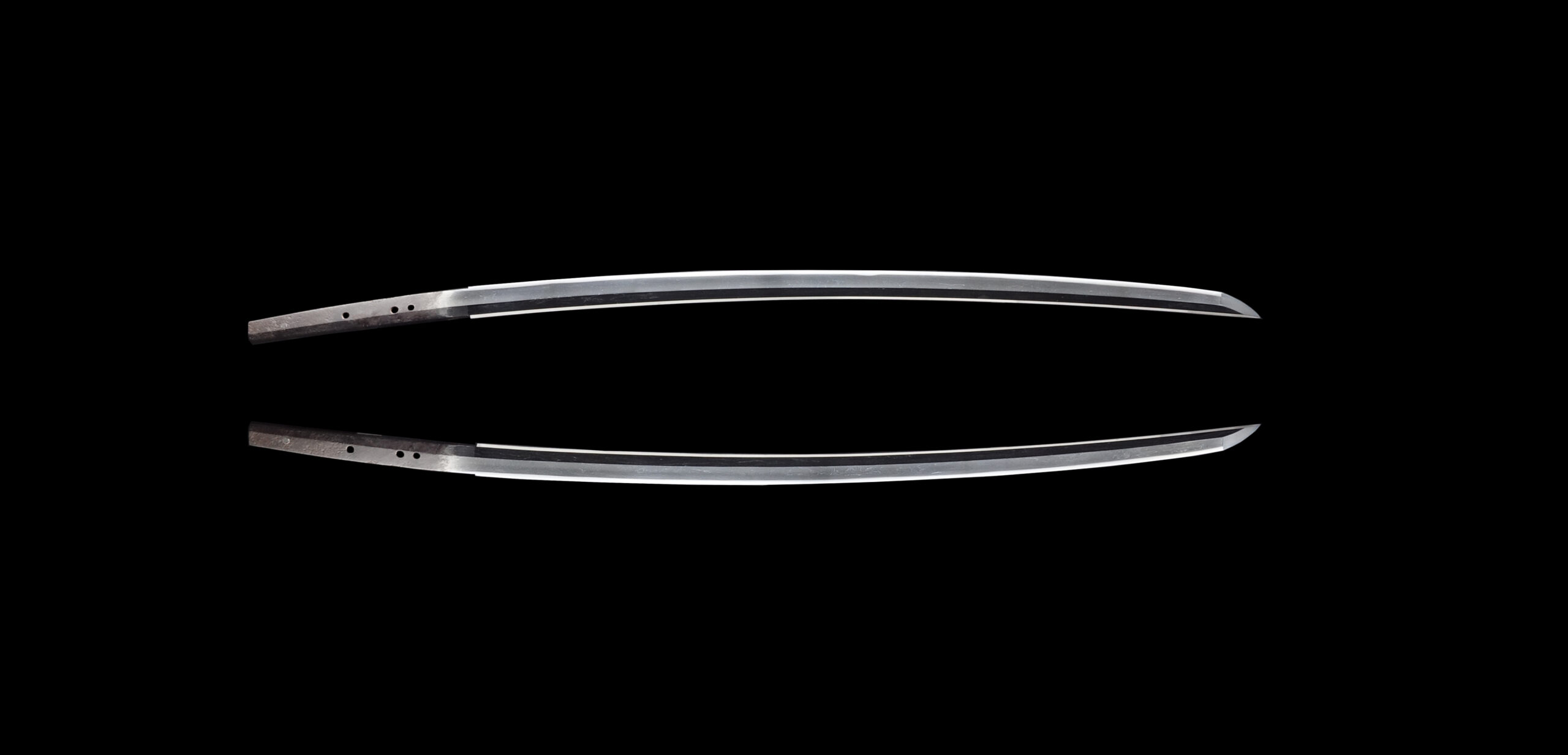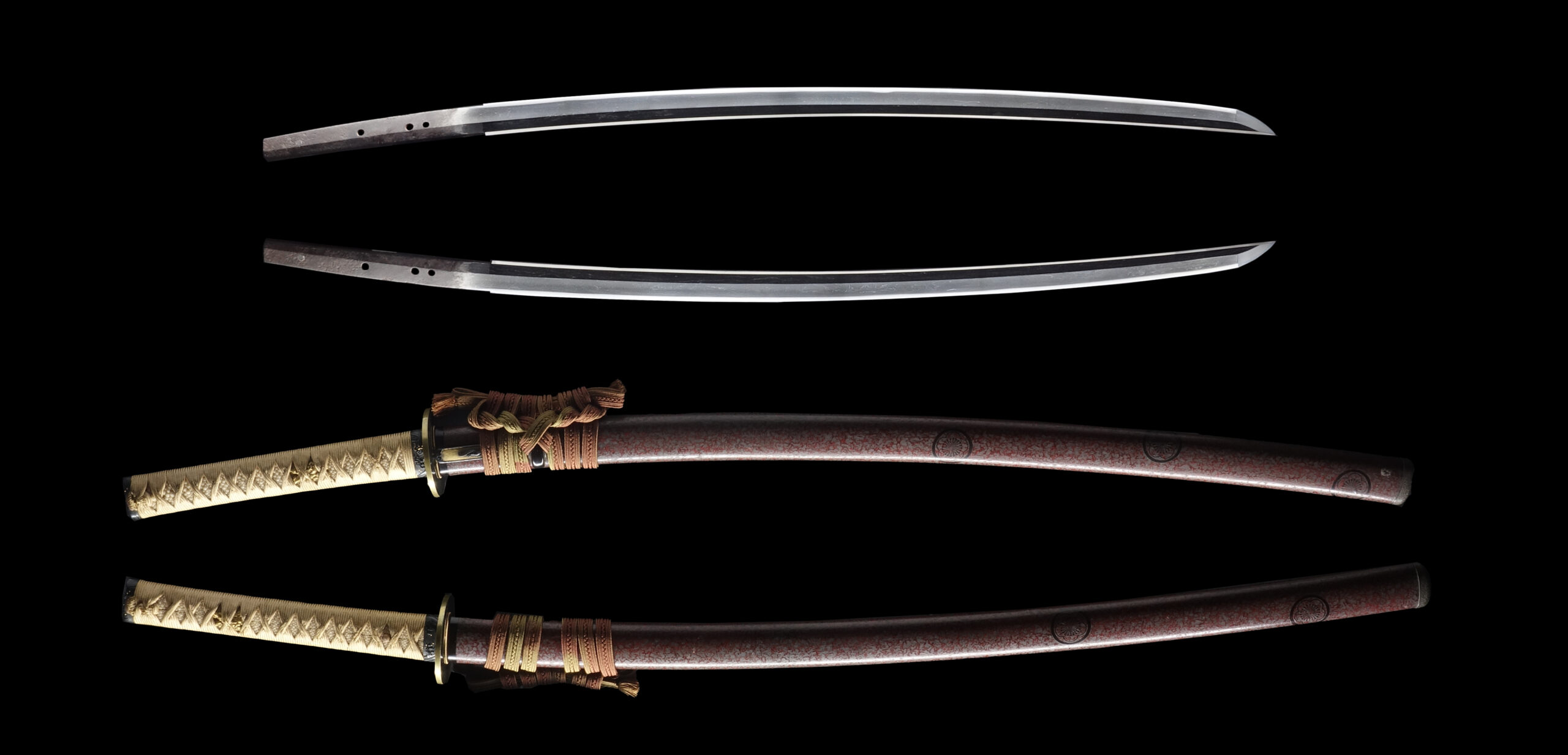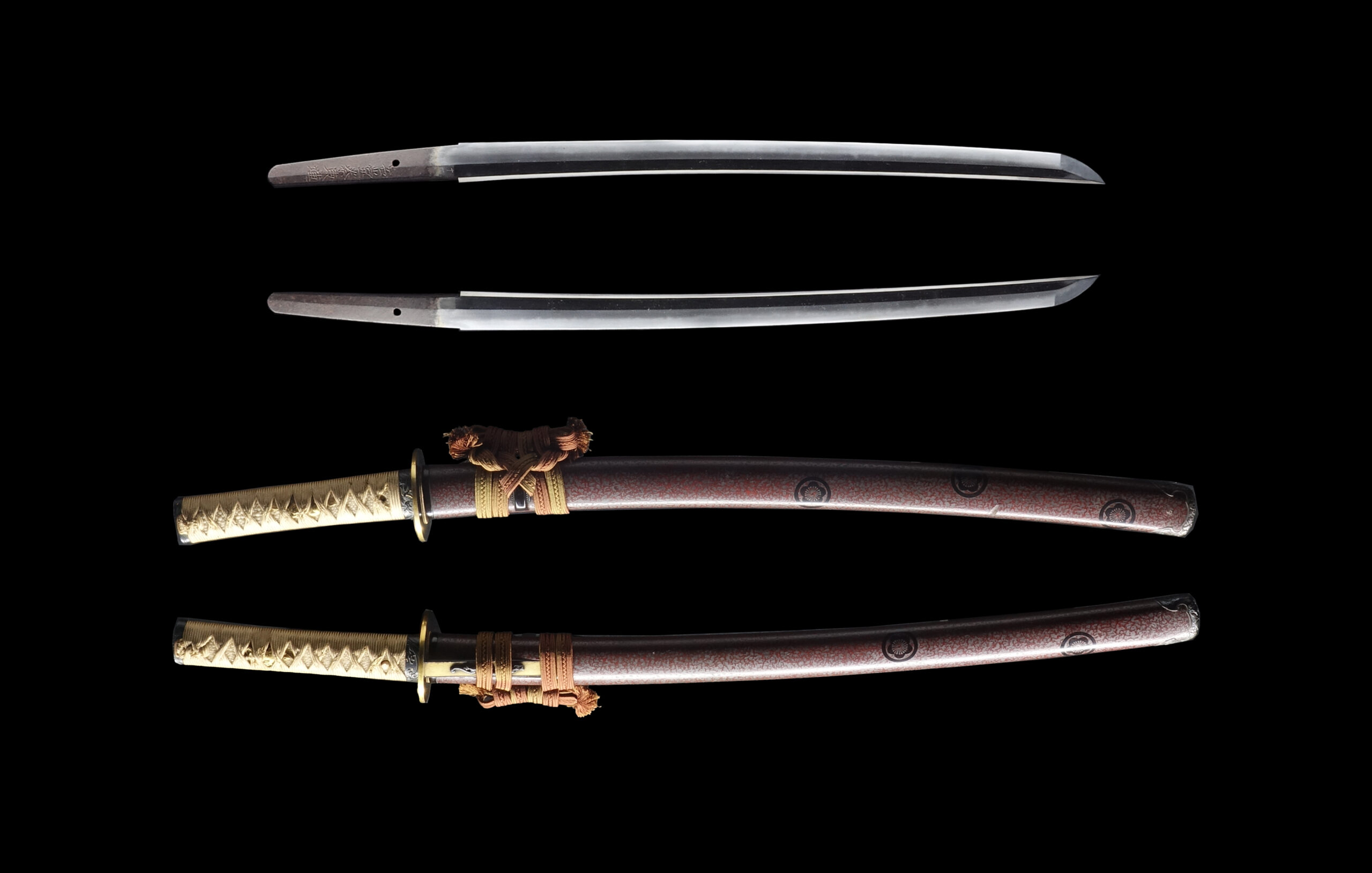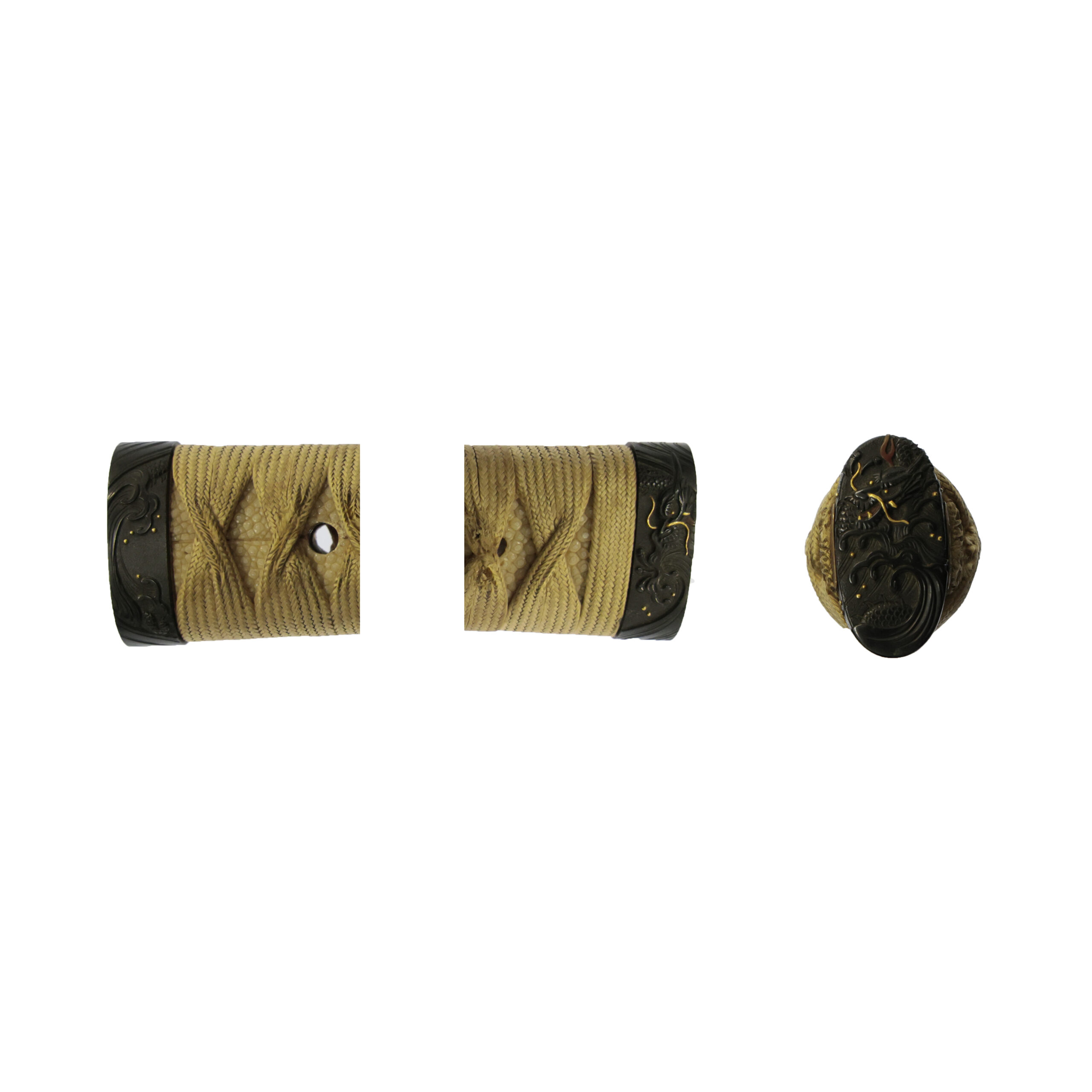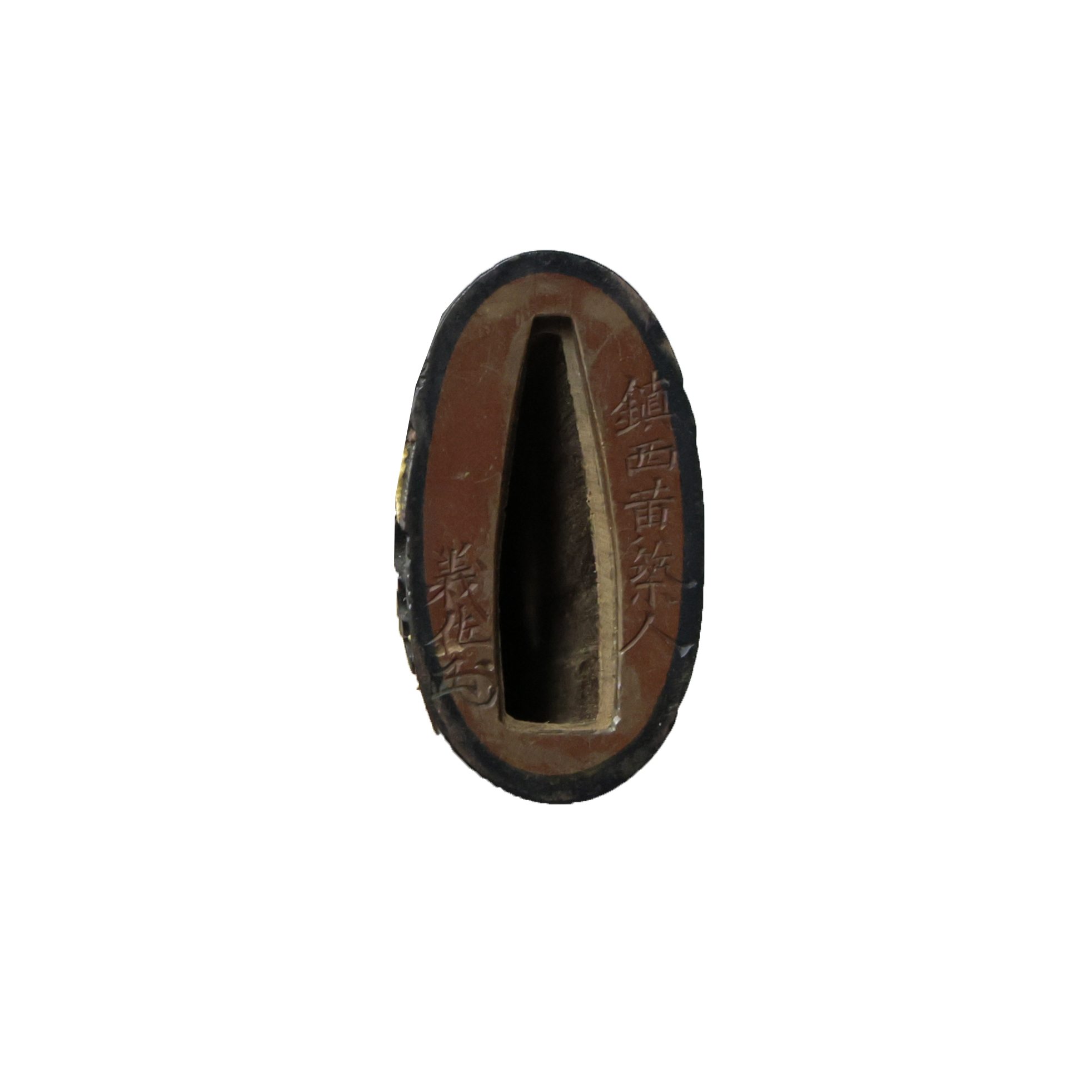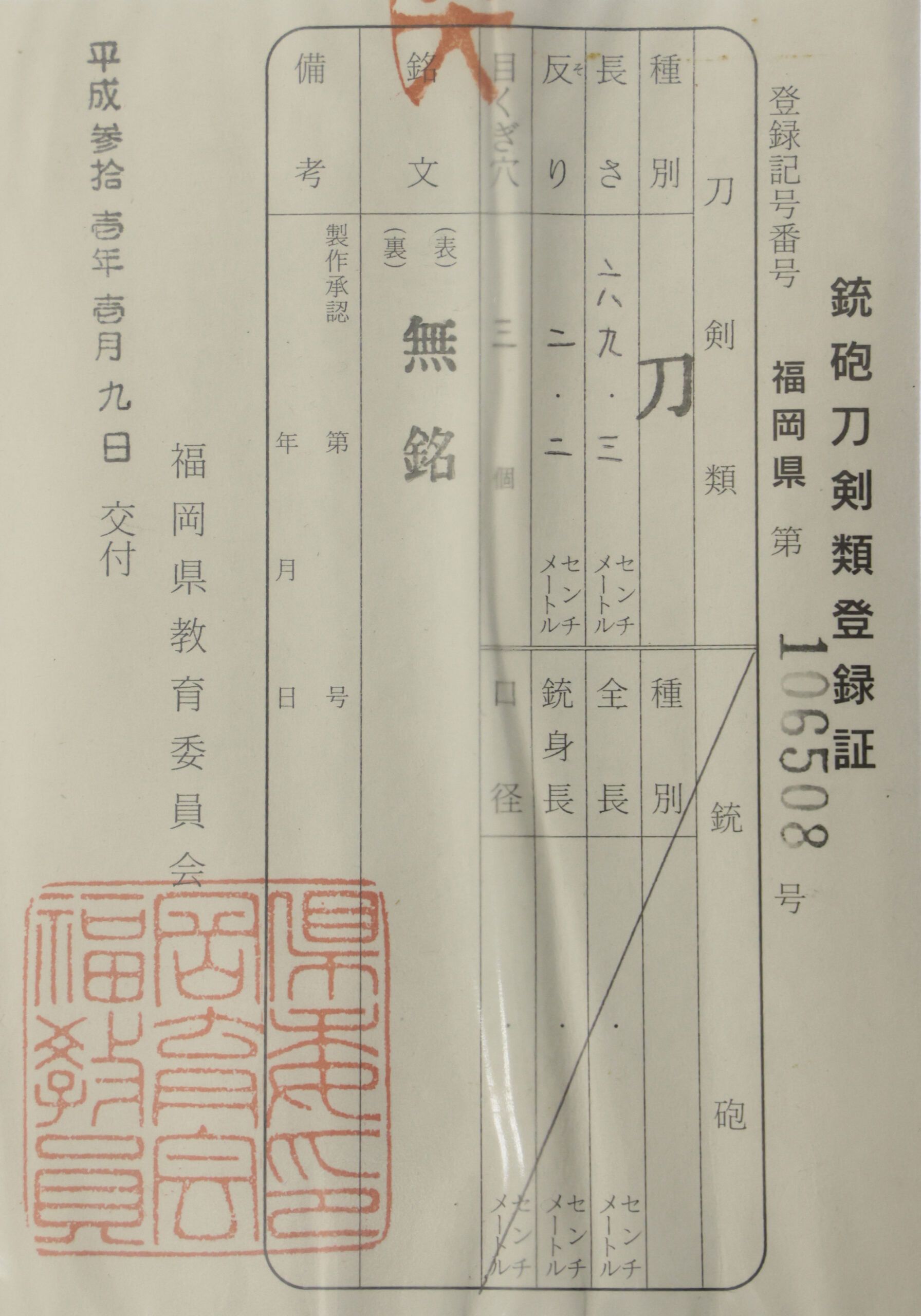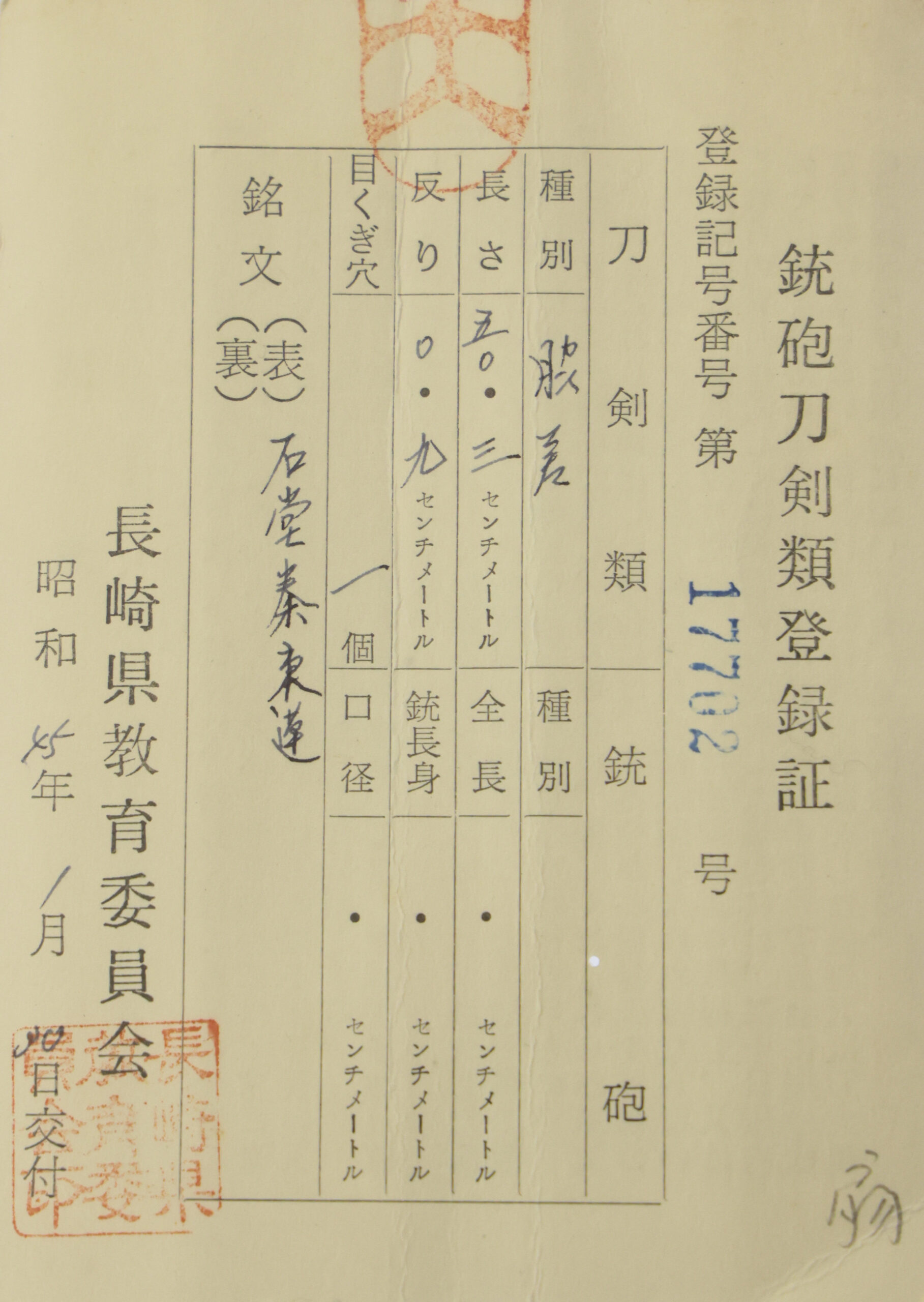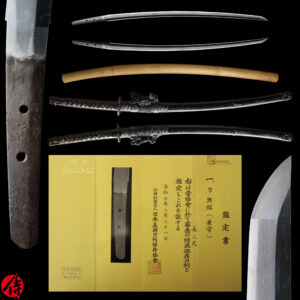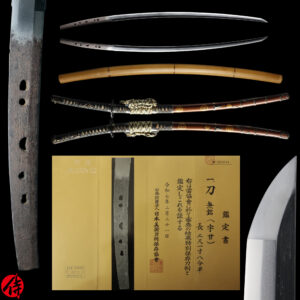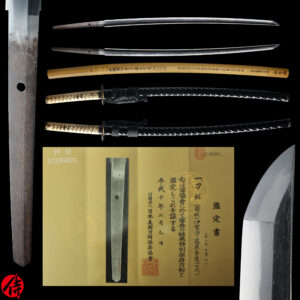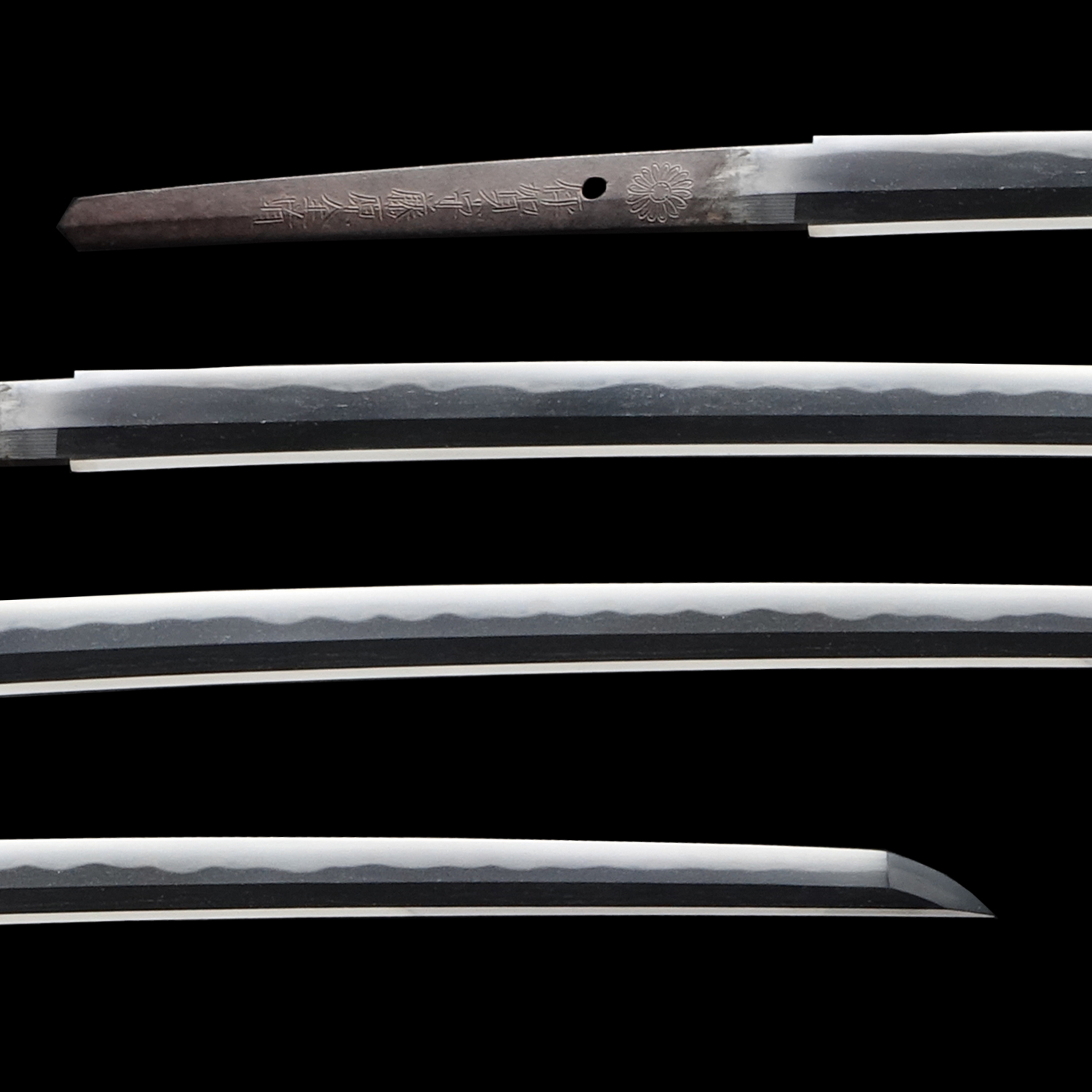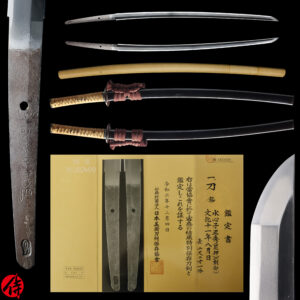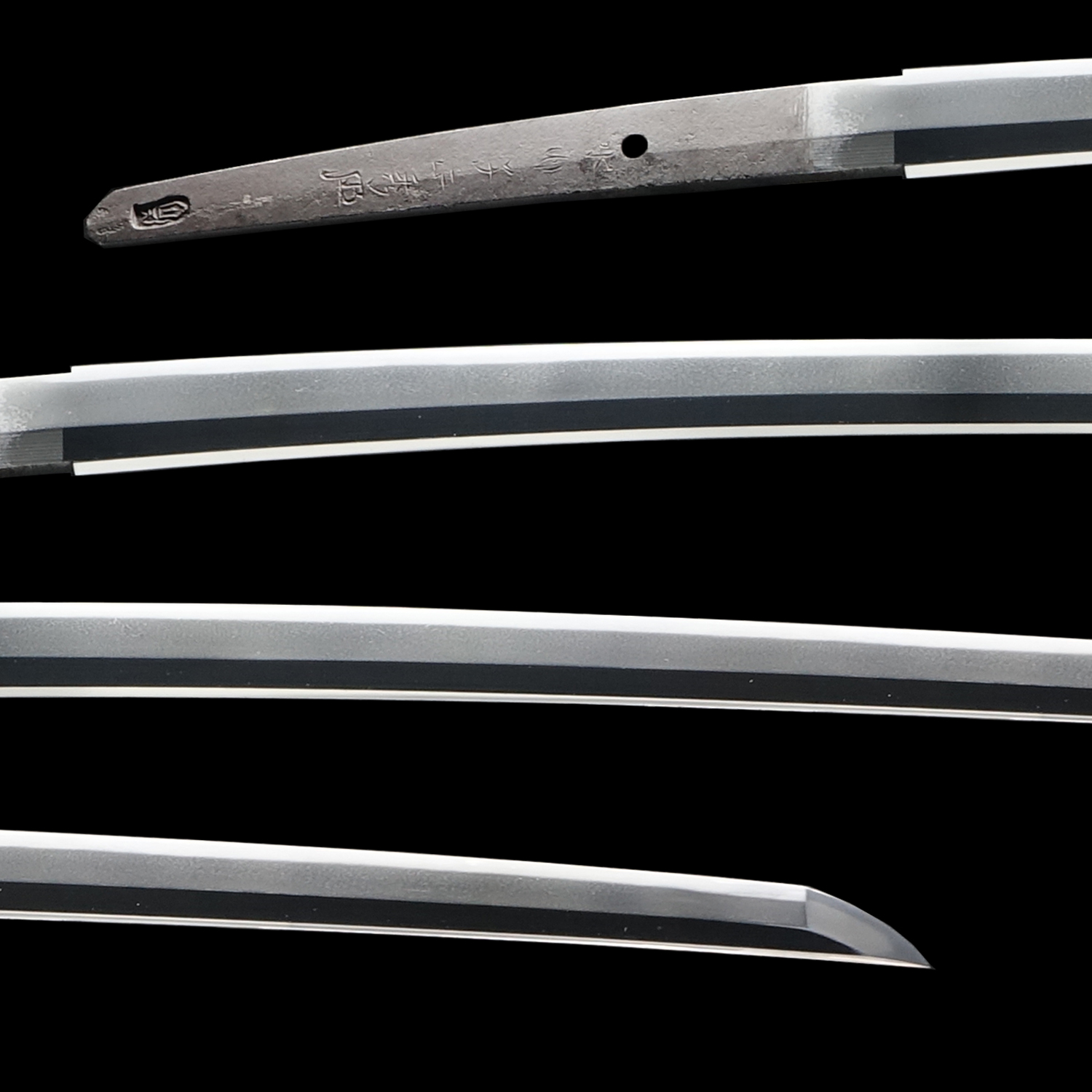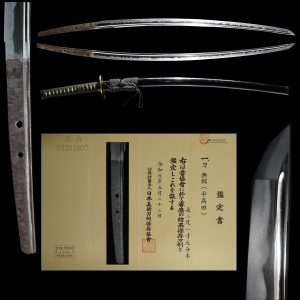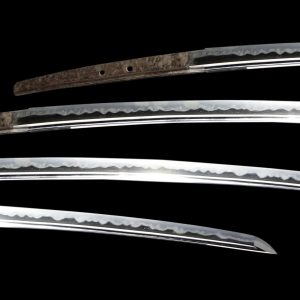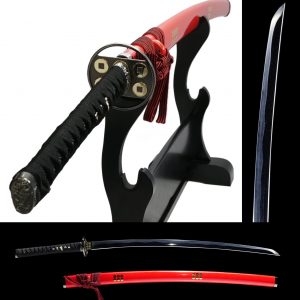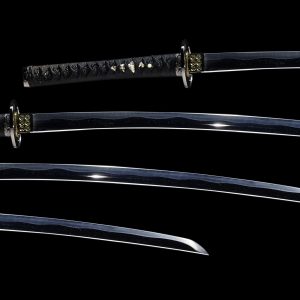Antique Japanese Sword Daisho Attributed to Ko-Mihara/ Signed by Ishidou Hata Toren with NBTHK Tokubetsu Hozon Certificate and Hozon Certificate
【Description】
–Katana
This blade is attributed to Ko-Mihara, a prestigious school in Bingo province (Today’s Hiroshima prefecture). According to recent studies, it is general knowledge that Mihara school was founded by Kokubunji Sukekuni (国分寺助国) in the late Kamakura period (Late13th century-Early 14th century). Two of the most prominent figures in this school are Mihara Masaie (三原正家) and his son, Masahiro (正広).
Mihara school is divided into three categories in Japanese sword terminology depending on the period. When the blade is older than the Nanbokucho era(the 1300s), it is called *Ko-Mihara (Old Mihara). And it is called Mihara for those forged in the early-Mid Muromachi period. Finally, Sue-Mihara(Late Mihara) is used for the late Muromachi period. Based on the NBTHK appraisal of this blade, it was approximately forged during the late Kamakura- Nanbokucho era (Early-Late 14th century). That means it is about 600 years old.
In Bingo province, many lands were owned by politically powerful temples of the Yamato region (today’s Nara prefecture) from ancient times. And many Samurai formed military groups to protect those lands, being hired by temples. And quite a few swordsmiths moved from the Yamato region to the Bingo region to forge blades for those Samurai.
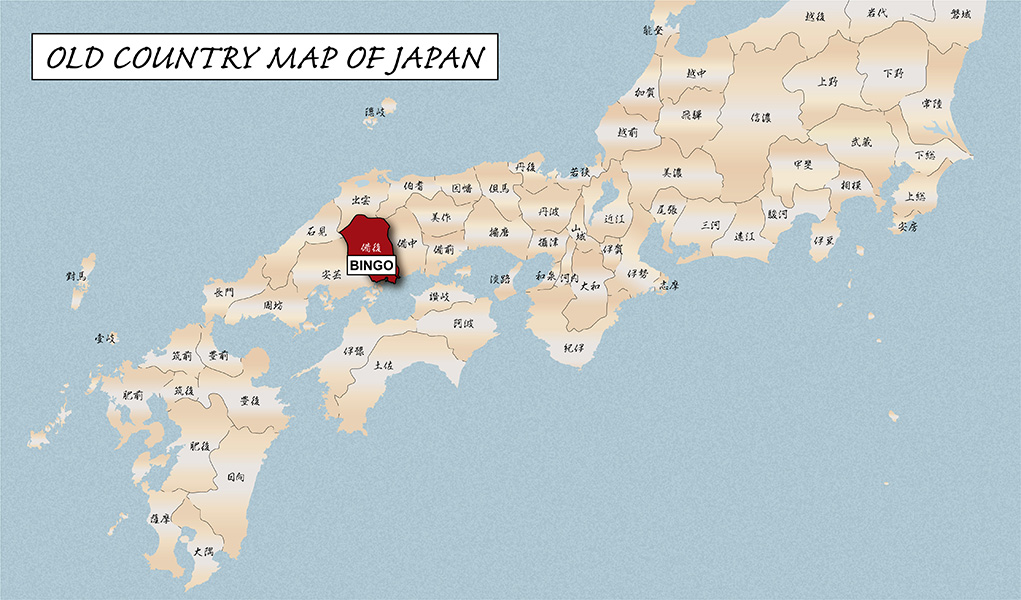
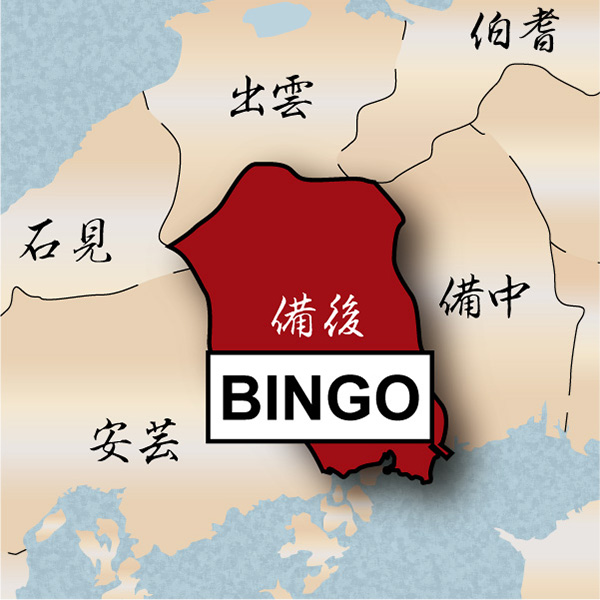
It is said that the swordsmiths in Yamato region strongly influenced how swords were forged in the Bingo province because of the history above. The blades forged by Mihara school had distinctive characteristics of Yamato DEN, one of the five Japanese sword traditions (Gokaden). The swordsmiths in the Bingo province, including Mihara school, produced many swords during the late Kamakura period-Muromachi period due to the high demand for weapons.
Bingo is located near the Chugoku Mountains, where iron sands, one of the essential materials for making Japanese swords, were abundant. This geological location contributed to the Mihara swordsmiths forging high-quality refined blades. We presume Bingo was quite active in sword-forging from ancient times.
The swords forged in Yamato DEN tradition are famous for their beautiful Jigane, steel surface, and straight tempering line(Suguha). This blade has a beautiful Jigane with a Suguha tempering line, which shows an outstanding characteristic of the Yamato DEN sword.
-Wakizashi
This wakizashi bears the signature of Ishido Hata Toren (石堂秦東蓮), also known as, Ishido Morihisa, a swordsmith of the Edo Ishidō school.
His original name was Ishido Hachizaemon, and he came from Mino Province before later adopting the name Tōren. He is said to have lived in Bushū Edo’s Toshima area and also in Kōnosu. His works are signed in various ways, such as “Bushū-ju Hata Morihisa,” “Bushu-ju Ishido Hata Morihisa,” “Bushu Toshima-gun Edo-jū Ishidō Hata Morihisa,” and finally “Ishido Hata Toren.” He is especially renowned as a skilled smith (wazamono) of the Edo Ishido line.
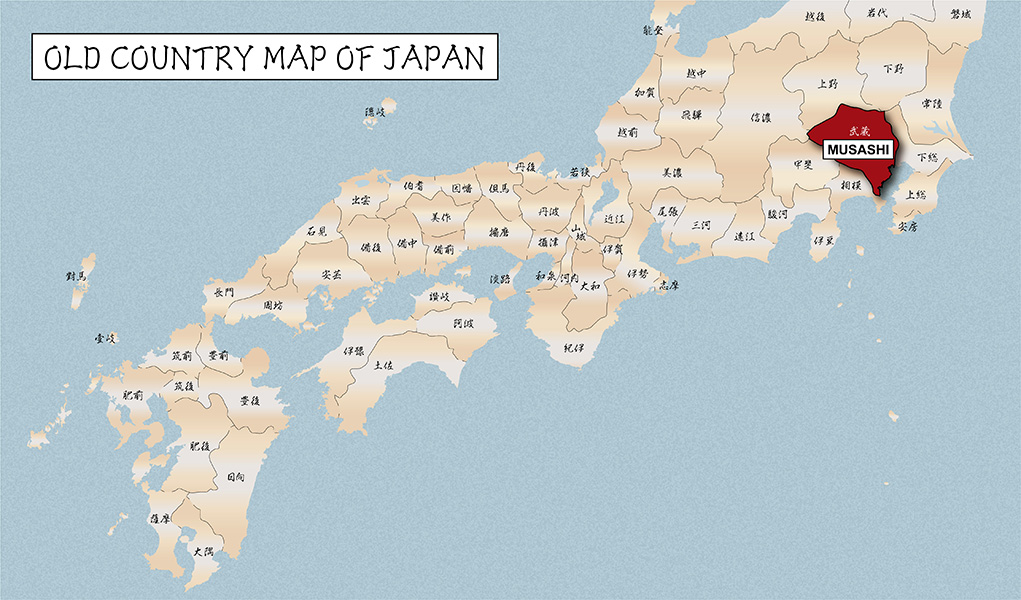
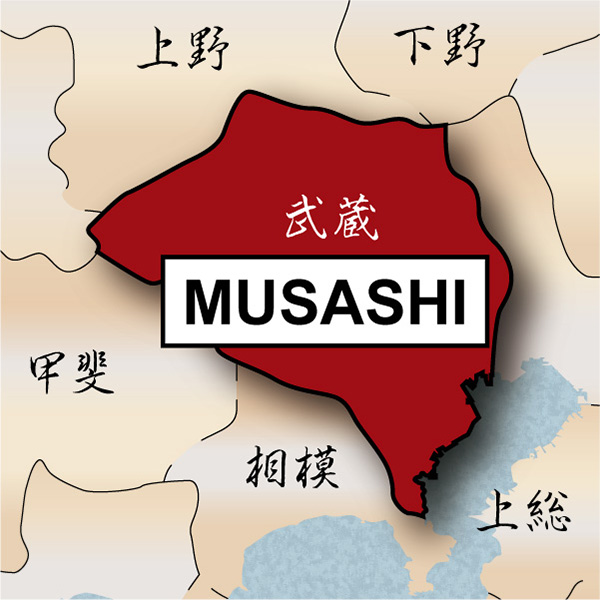
The Foundation of Ishido School
Ishido school was founded by Sukenaga, an offspring of Ichimonji Sukemune, who made Fukuoka Ichimonji school in Bizen province (Today’s Okayama prefecture). During 1492-1501 (Late Muromachi period), Sukenaga and his school moved from Bizen province to Omi province after being summoned by Gamou family, a powerful feudal line in that region. Sukenaga started to live in front of Ishido temple, and he changed his surname to Ishido.
It is said that Ishido Korekazu was the founder of the Edo Ishido school. He was originally from Omi Koku(Today’s Shiga prefecture). He was a descendant of Ichimonji Sukemune (一文字助宗) from Bizen Koku(Today’s Okayama prefecture). Korekazu moved to Edo (today’s Tokyo) and founded the school at the beginning of the Edo period. This school became one of the most popular ones in Edo city, Musashi Koku. Ishido Hata Toren belonged to this school.
As of the early Edo period, many Ishido swordsmiths moved to other parts of Japan, looking for better opportunities. There are four areas: Edo, Osaka, Kishu(Wakayama prefecture), and Chikuzen(Fukuoka prefecture).
What is Daisho?
Daisho is a pair of two Japanese swords Samurai carried. During the Edo period, having Daisho in public places was considered social status for Samurai. Furthermore, Samurai were required to wear them under the law back then. Daisho is written as 大=Big and 小=Small. Dai part means Katana, and Sho part means Wakizashi. We are confident you would like this pair of Daisho Koshirae.
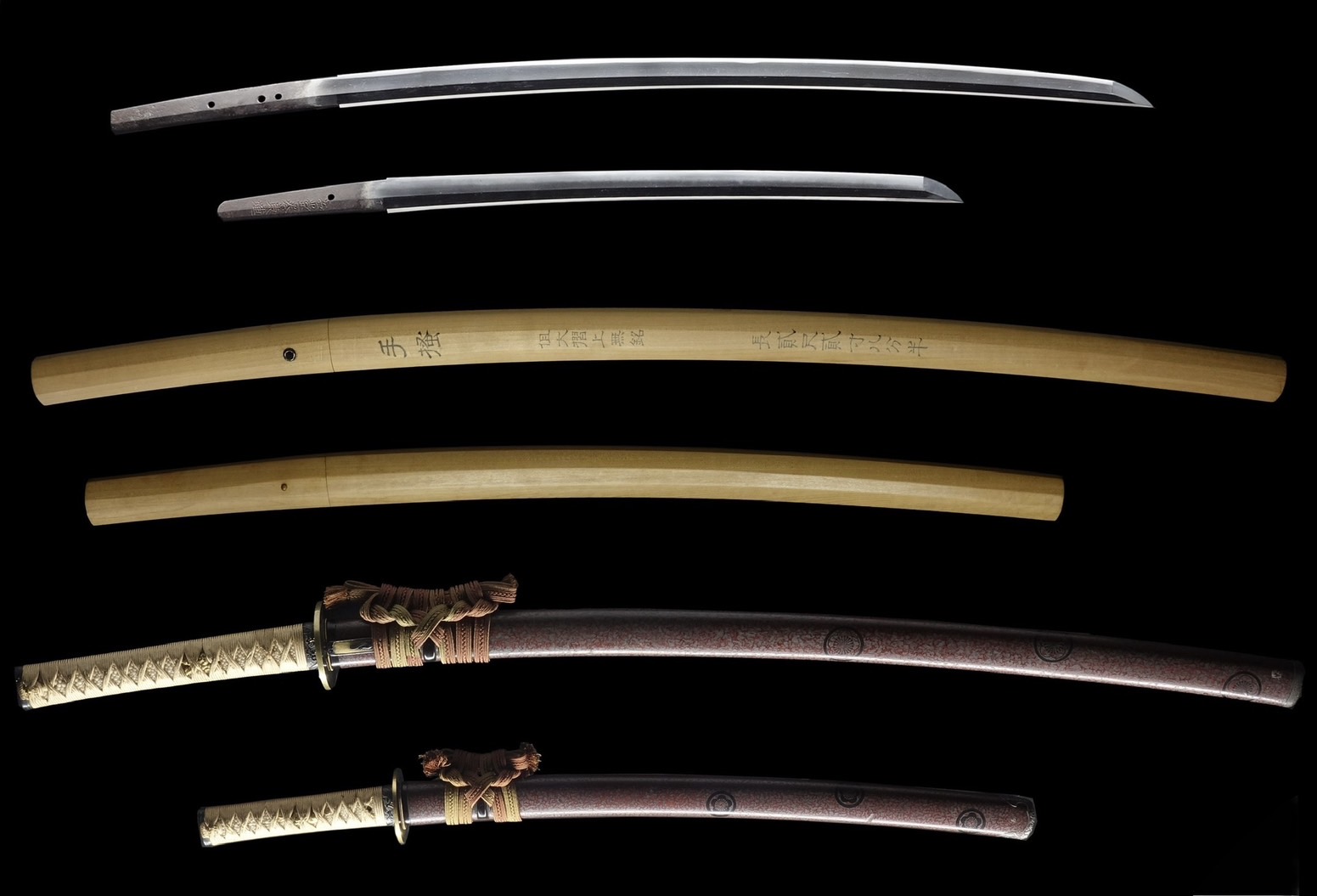
Appraisal
This Katana blade was appraised as a Tokubetsu Hozon Token (特別保存刀剣) and the Wakizashi was appraised as a Hozon Token. They were issued by NBTHK (Nihon Bijutsu Touken Hozon Kyokai:日本美術刀剣保存協会). These authentication papers were only given to authentic Japanese swords, well preserved and high quality with artistic value.
*Please keep in mind that there are a couple of small Kitae Kizu on both blades. If you like to know the detailed condition, please feel free to contact us.
【Blade】
-Katana
Cutting Edge Length(Nagasa):69.6 cm (27.4 inches)
Curvature(Sori):2.12 cm (0.83 inches)

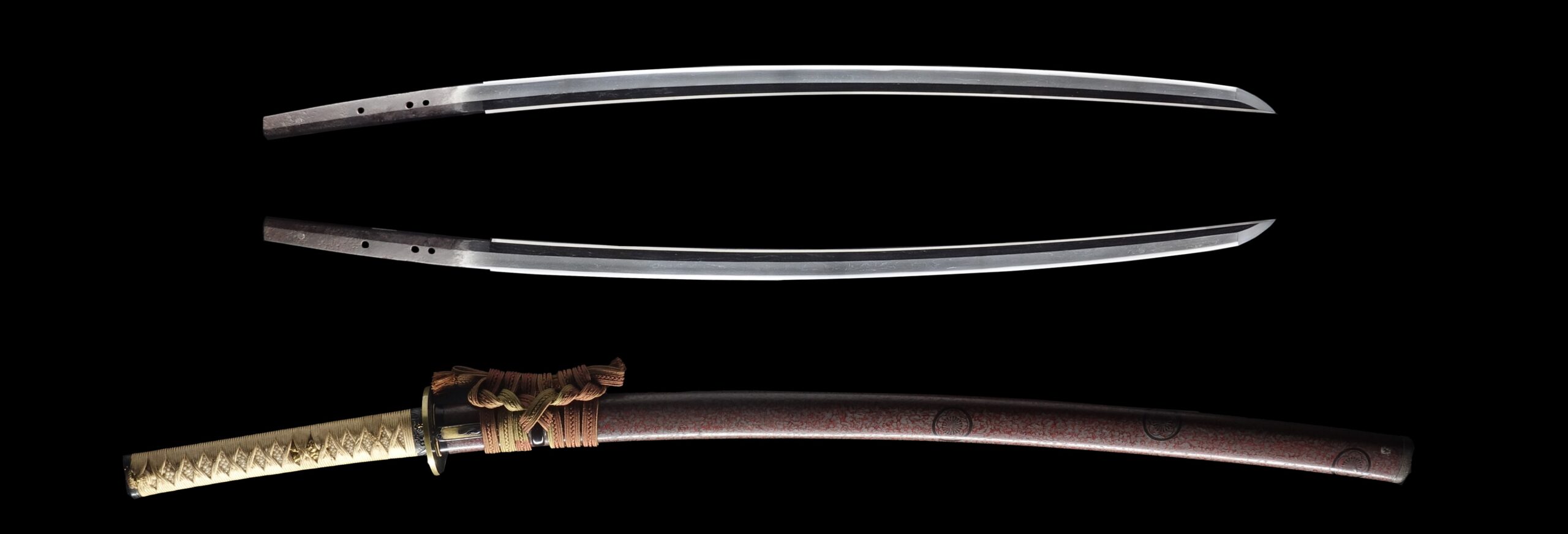
-Wakizashi
Cutting Edge Length(Nagasa):46.3 cm (18.2 inches)
Curvature(Sori):1.27 cm (0.50 inches)


Hamon:
The crystalline structure which forms along the cutting edge of a blade as a result of the hardening process
Jimon(Jihada):
visible steel surface pattern created by folding and hammering during forging process
-Katana
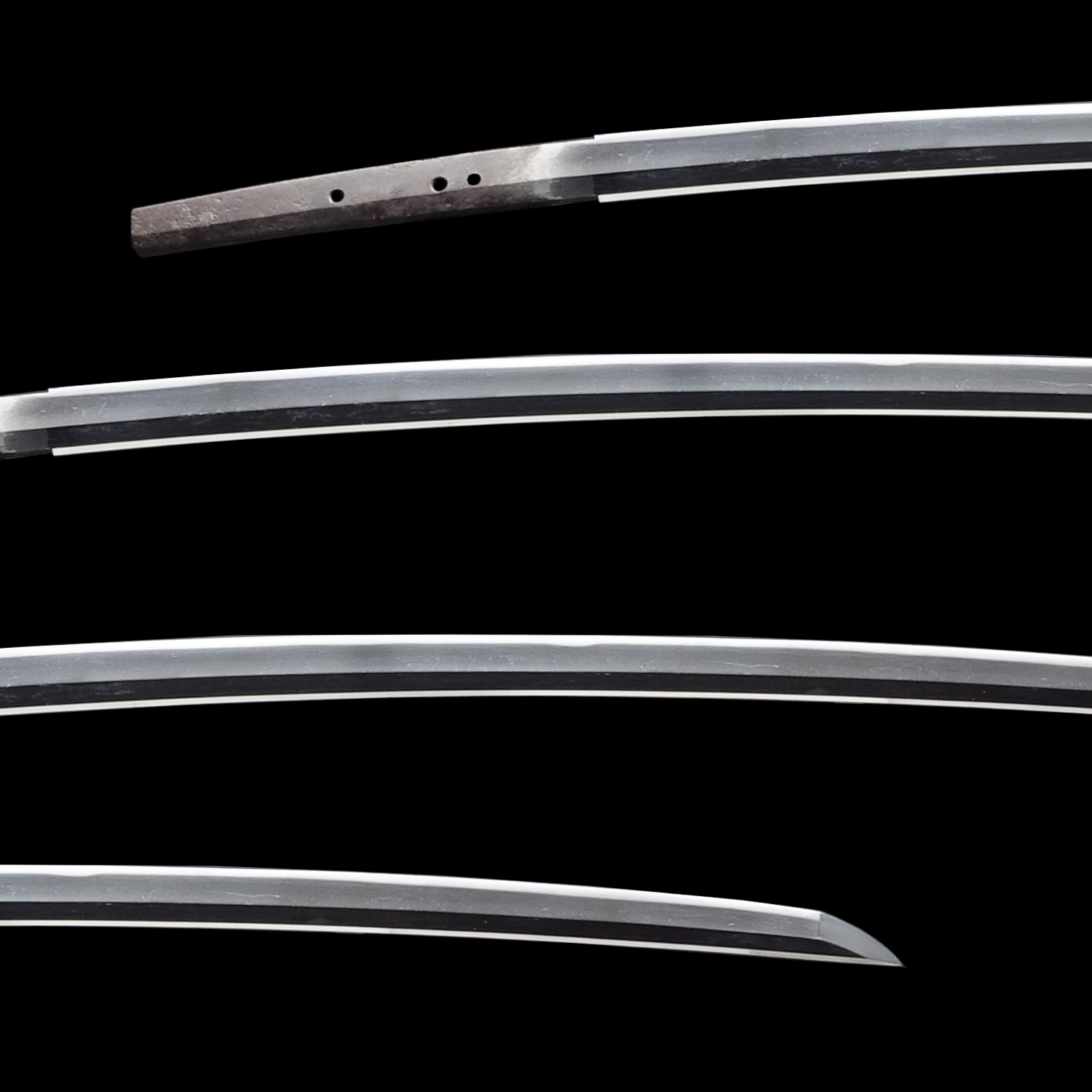
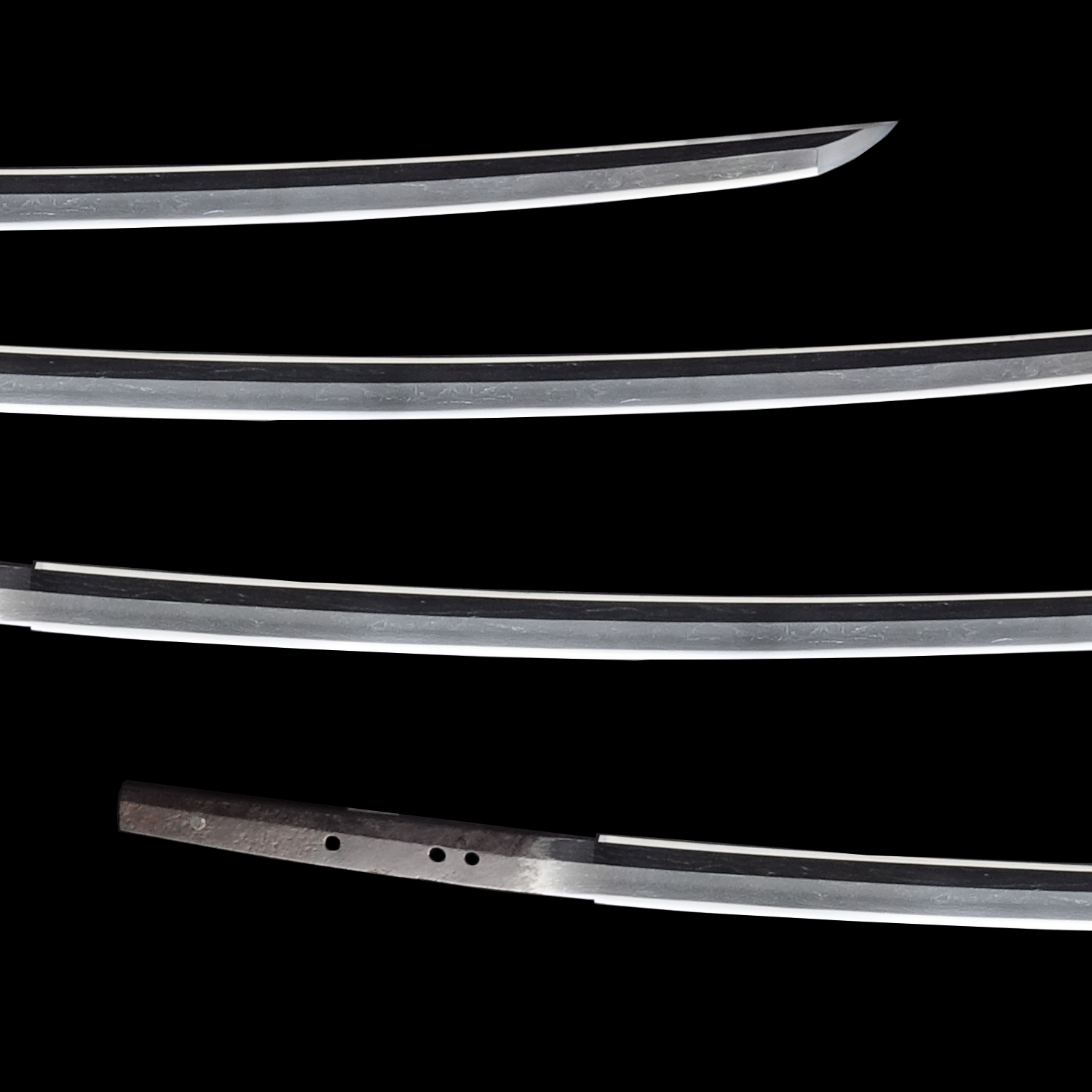
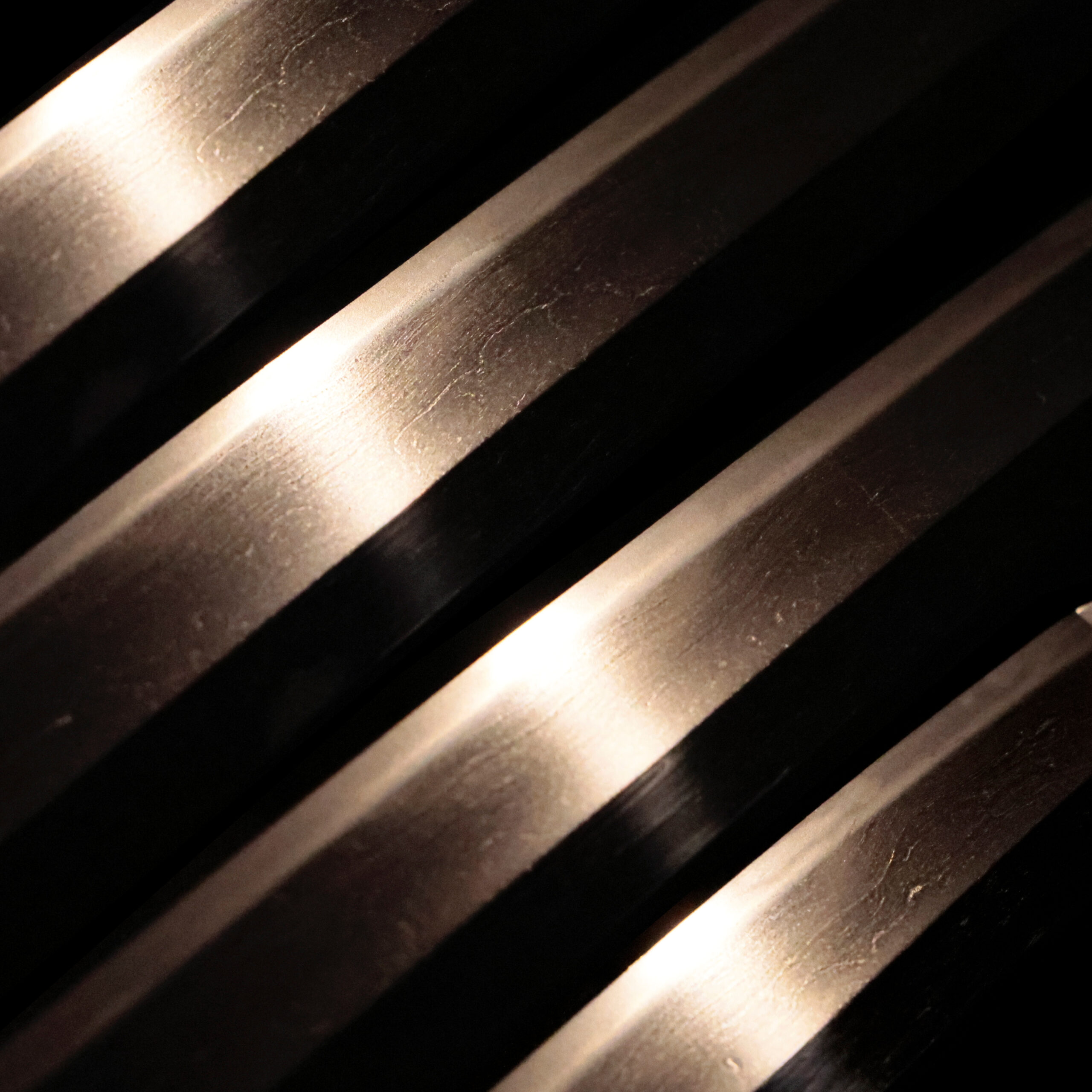
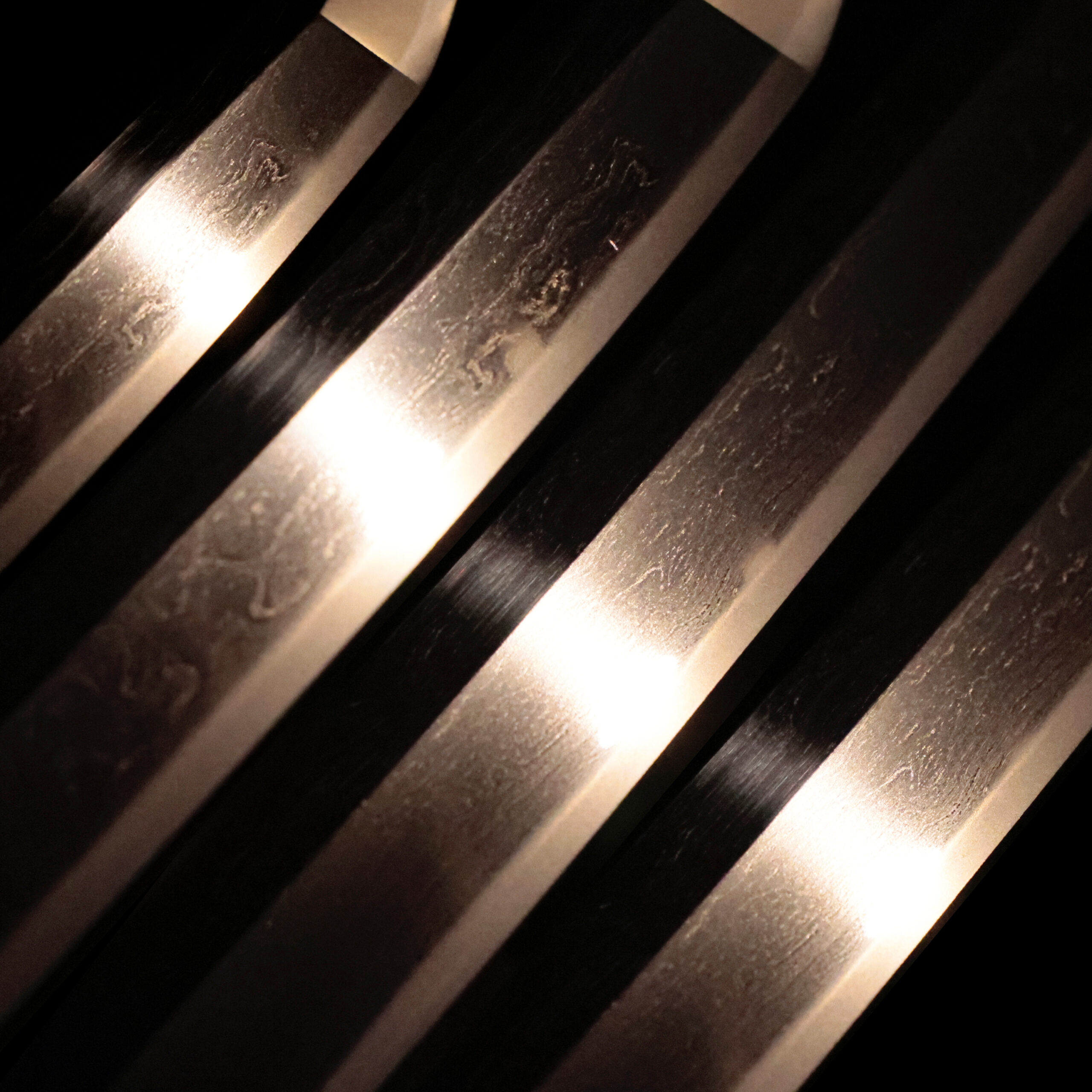
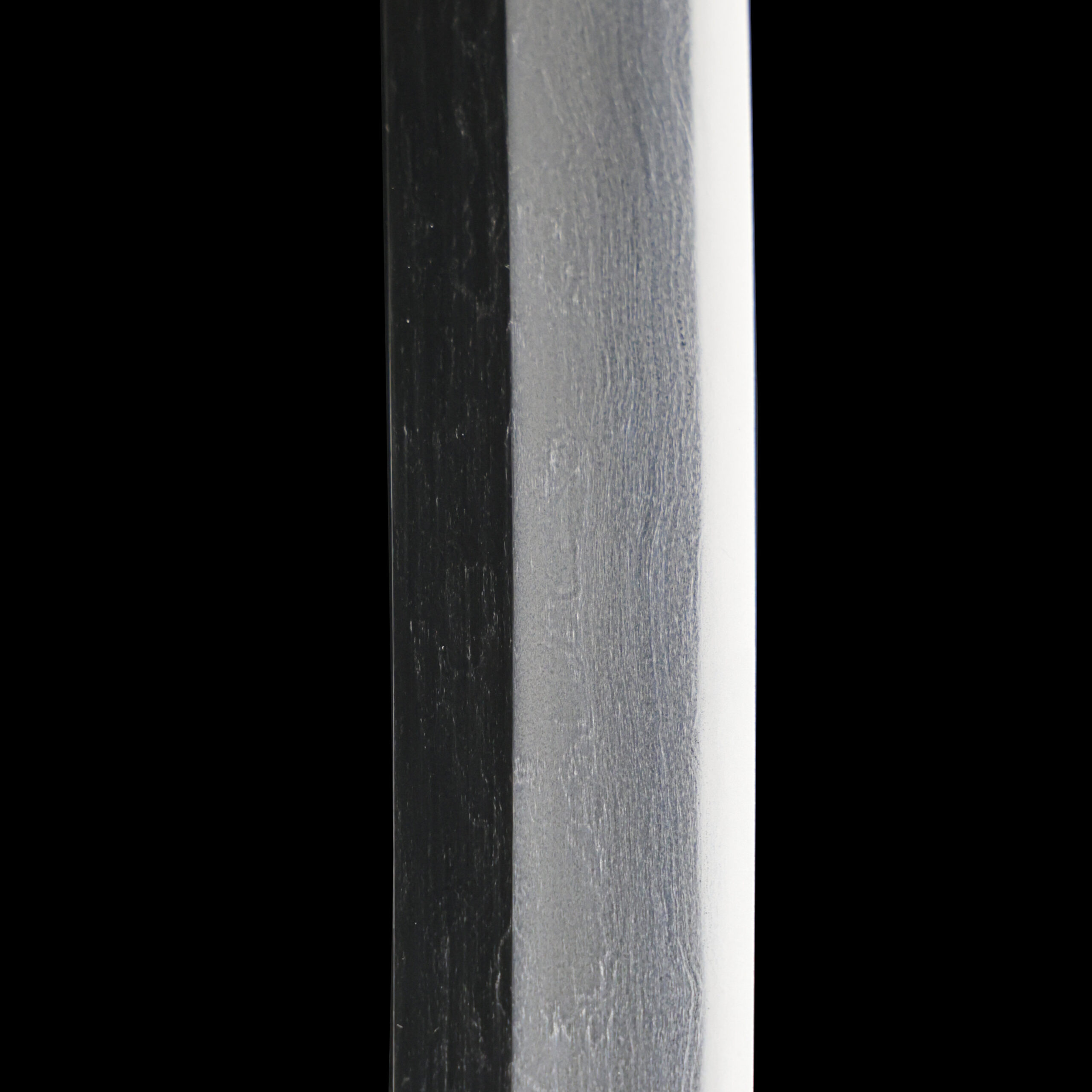
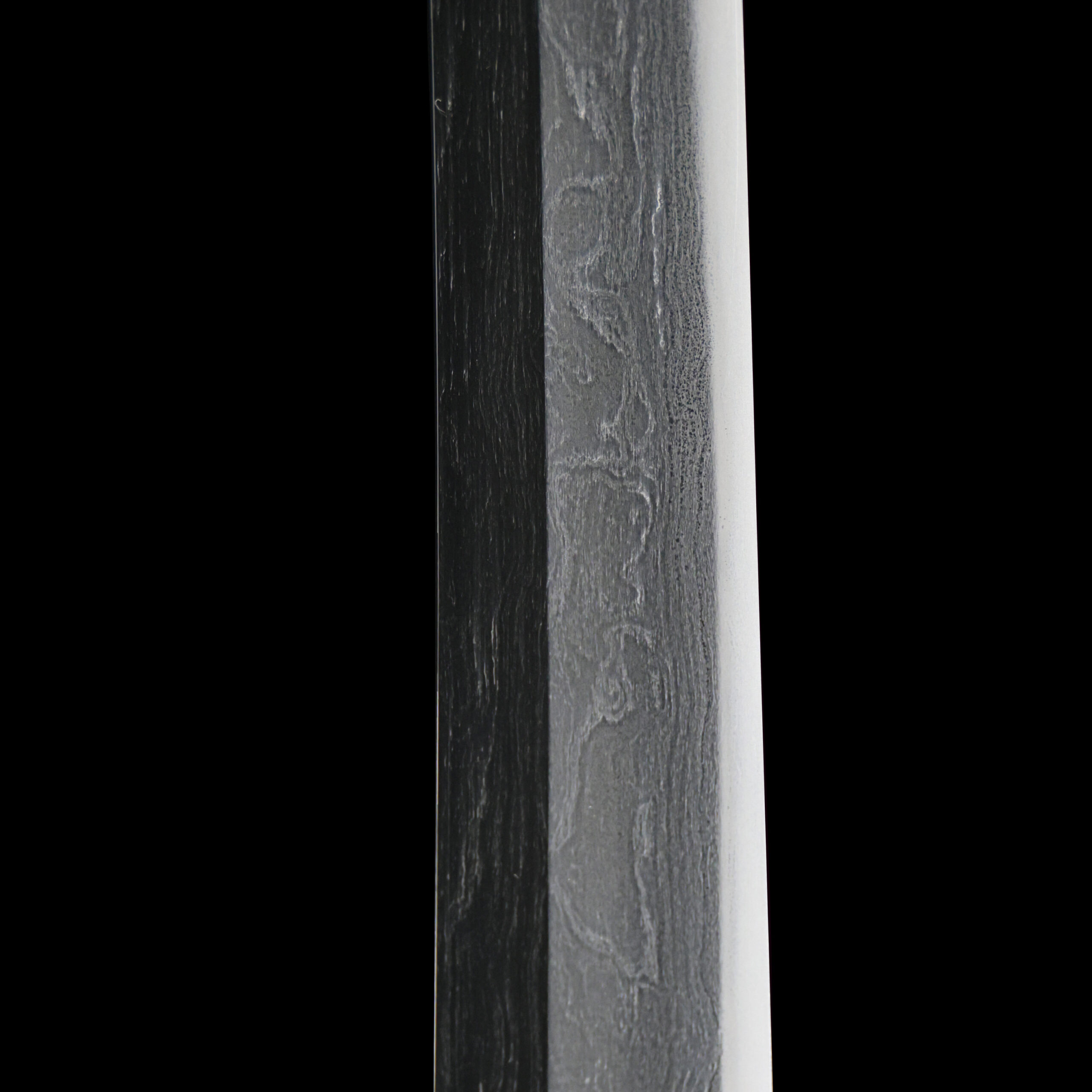
-Wakizashi
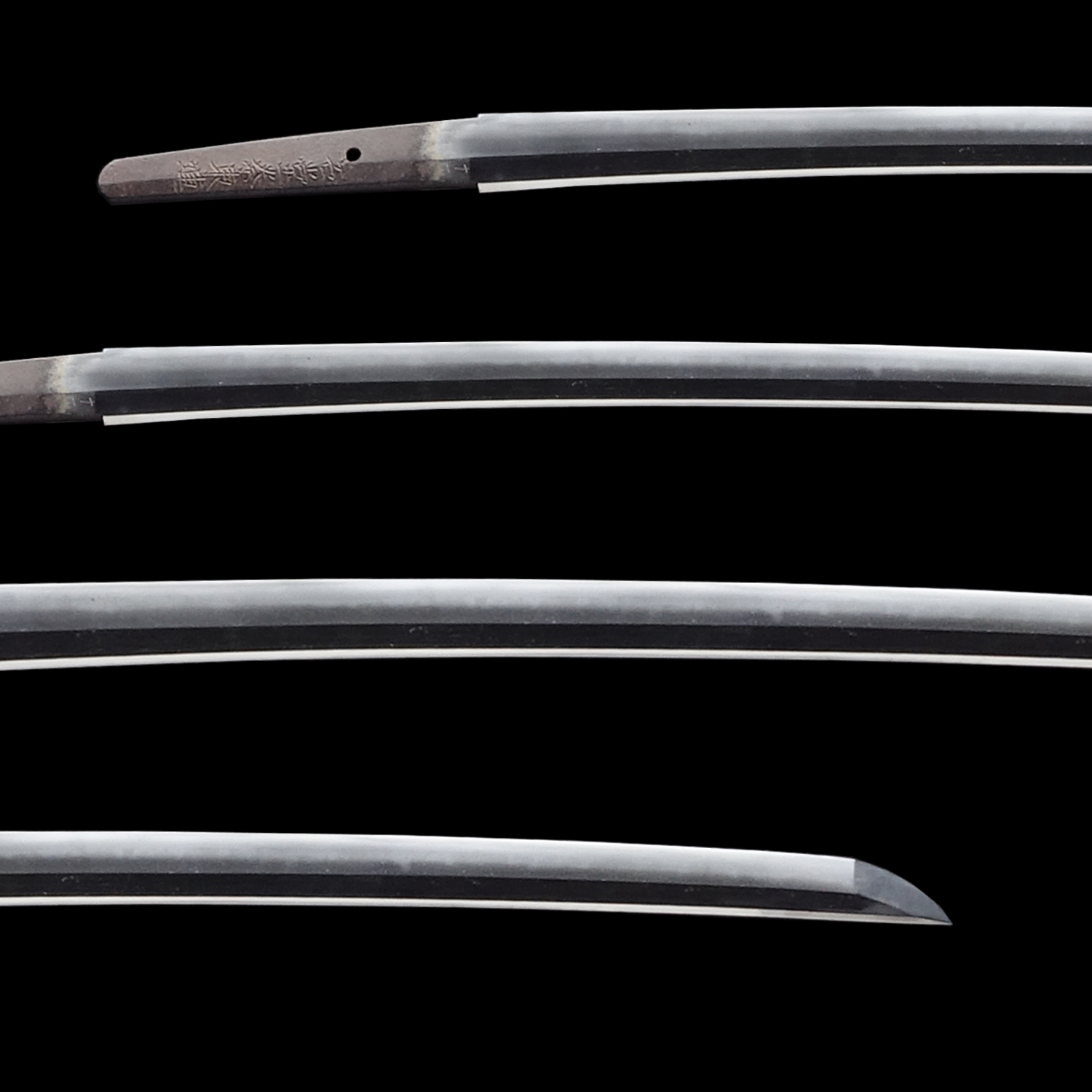
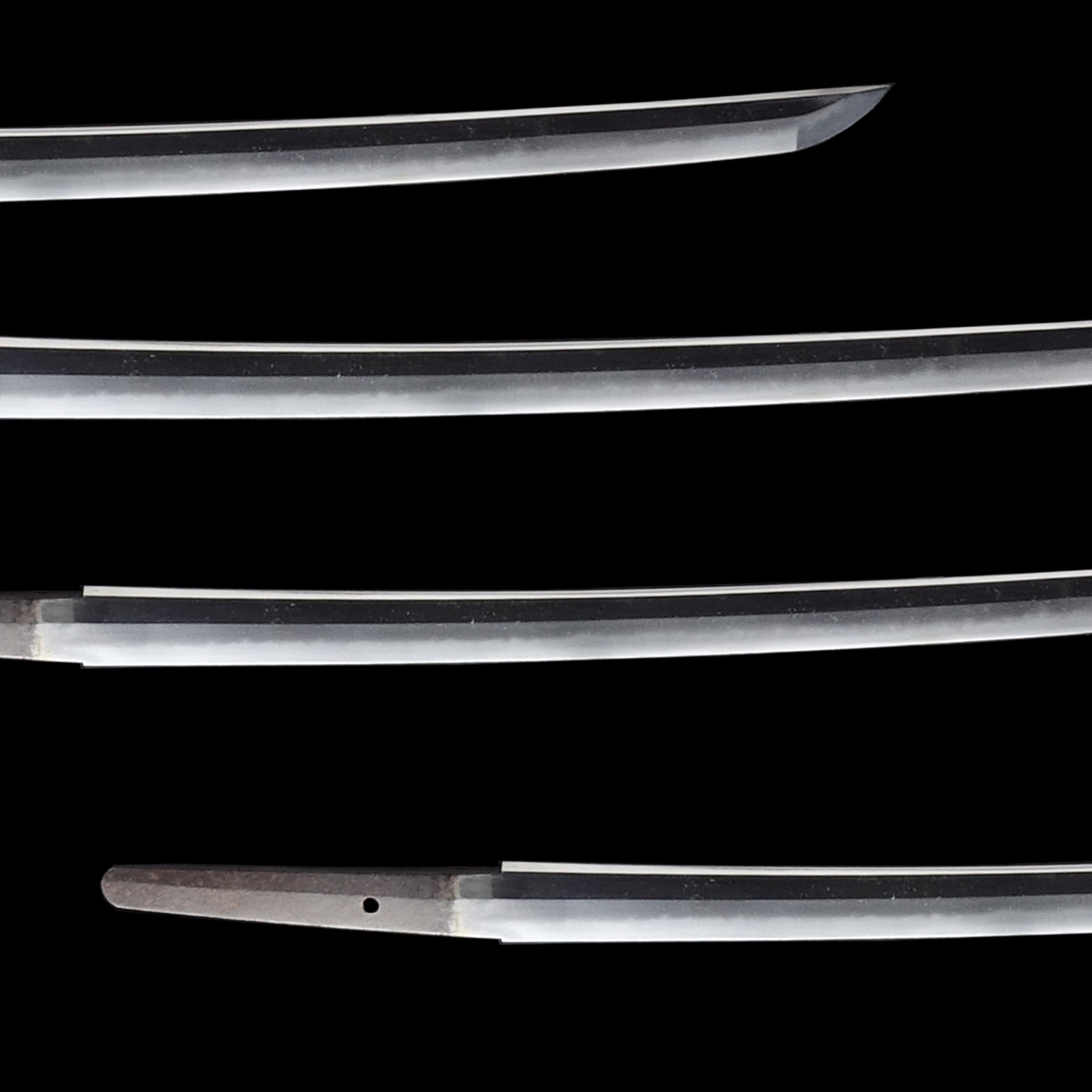
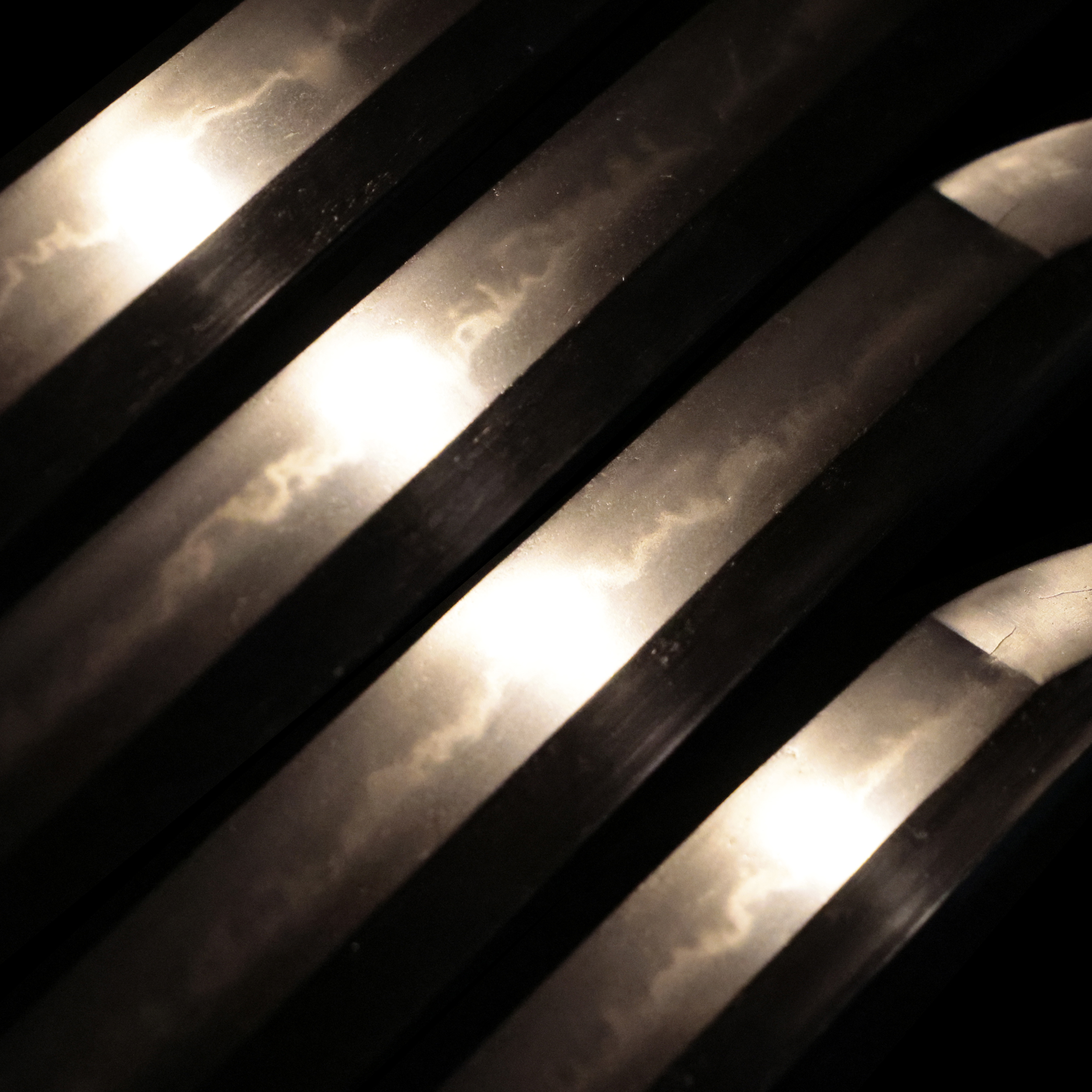
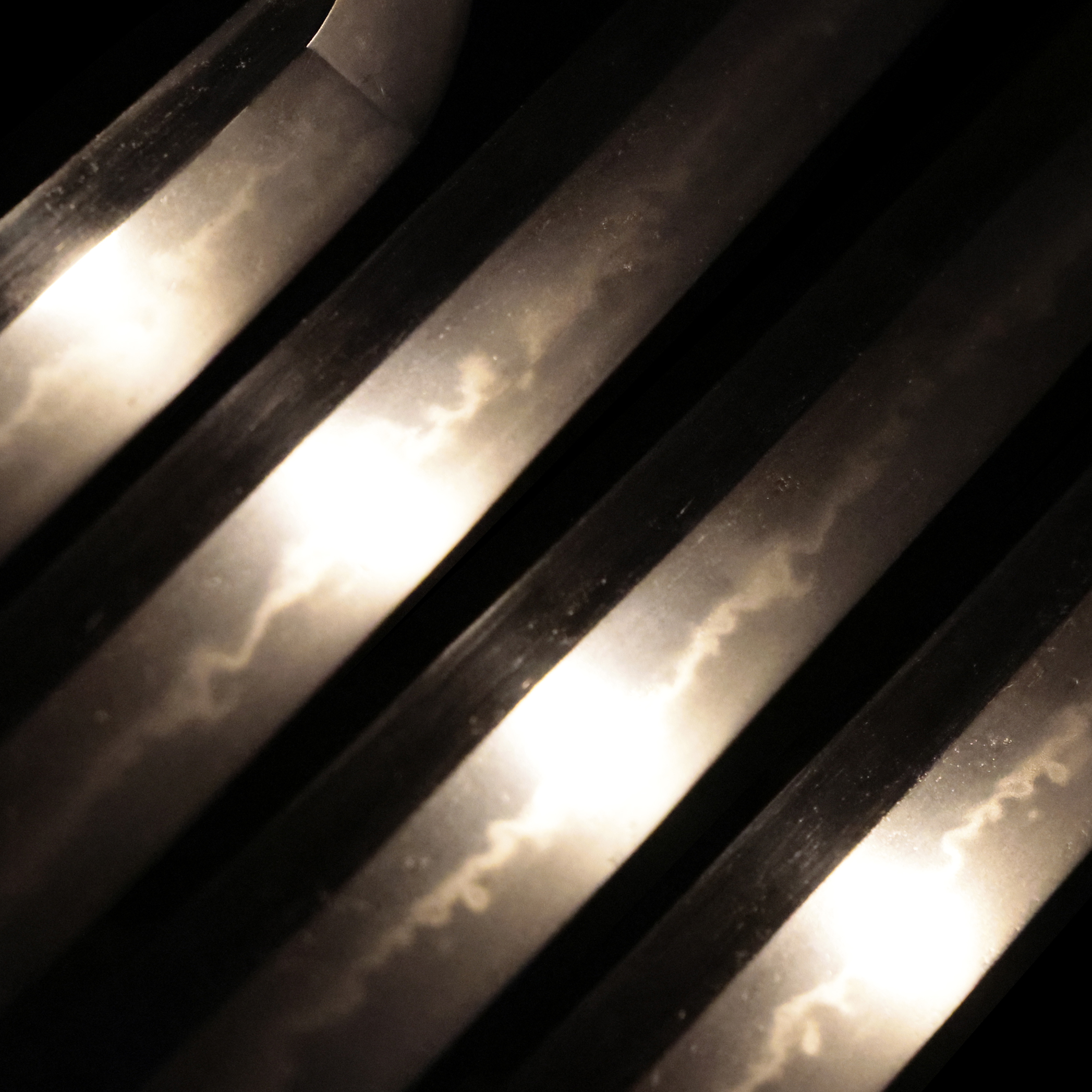
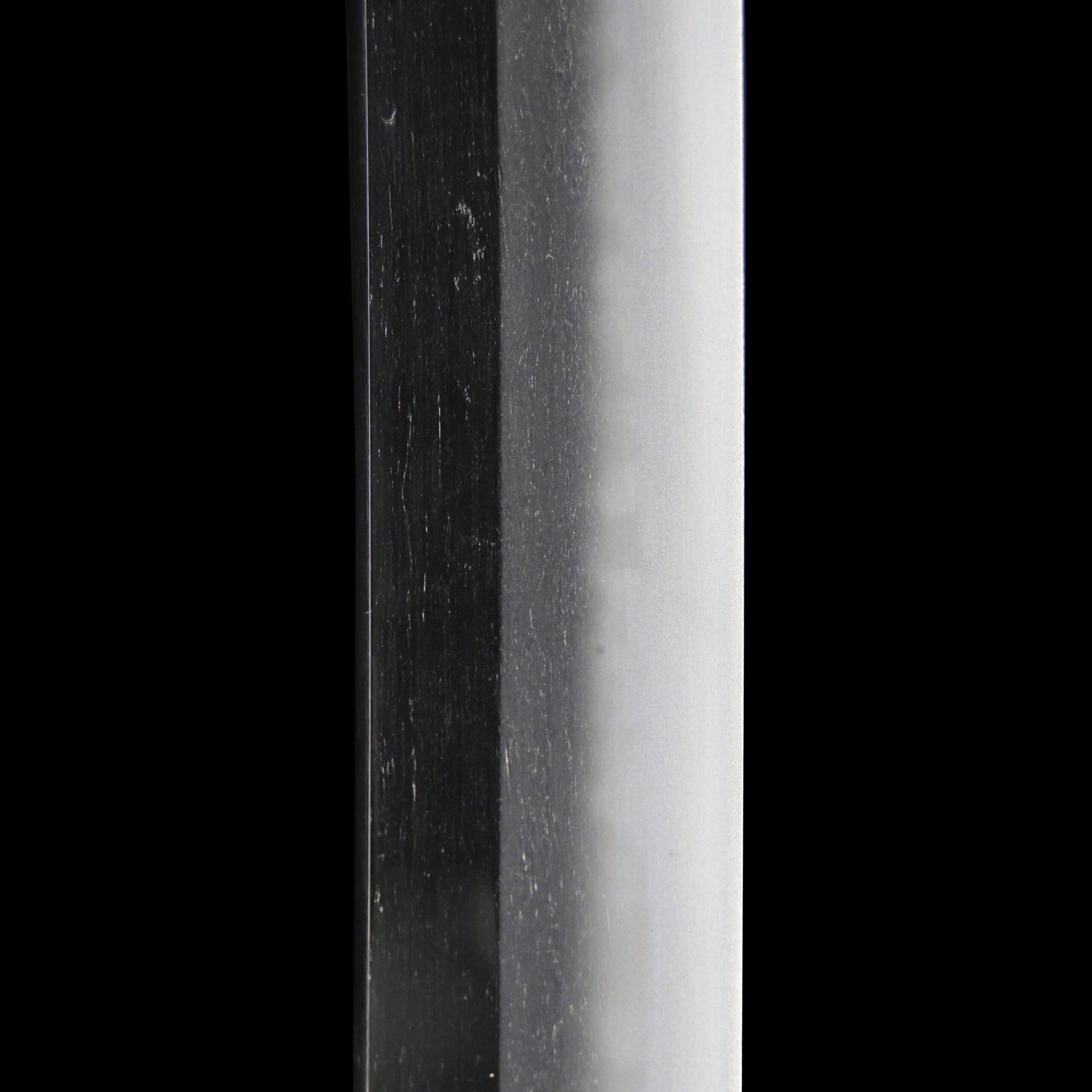
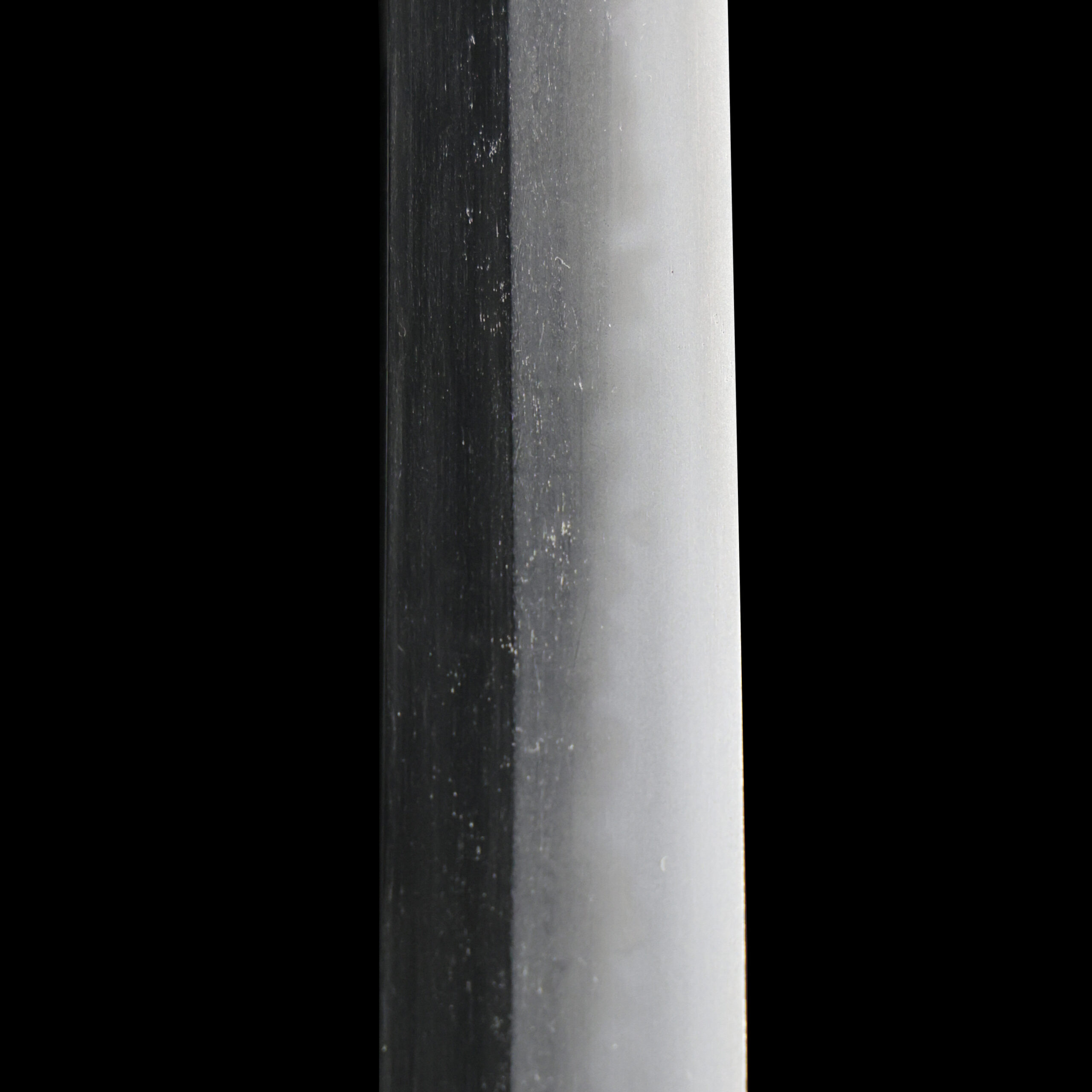
Kissaki:Kissaki is the tip of the Japanese sword.

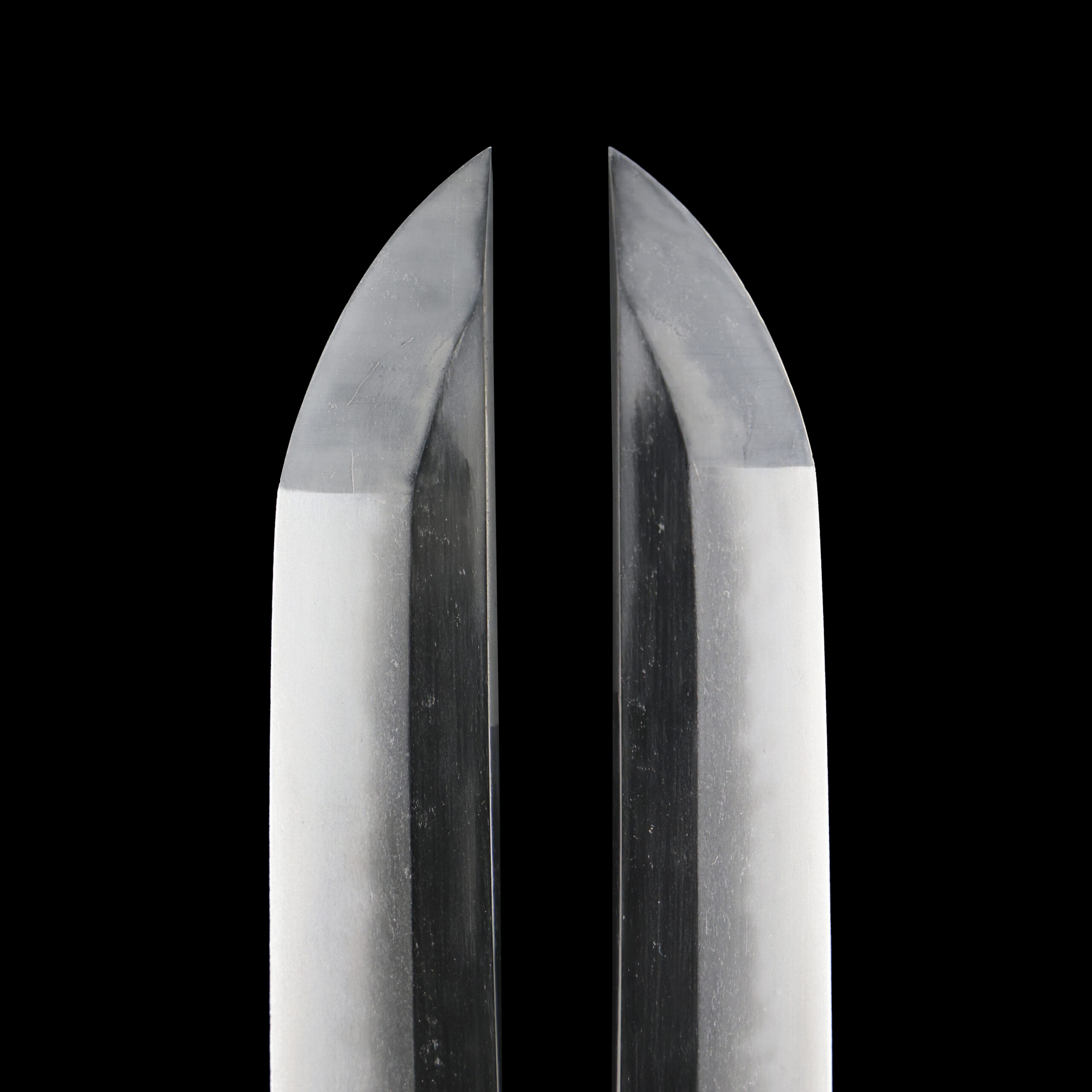
Nakago:Nakago is the tang of the Japanese sword.
Japanese swordsmiths left the black rust on the tang because it prevents red rust while the tang is in its handle. And the discoloration of the tang was created over time, and it is a great indicator for a Japanese sword specialist to estimate when the sword was forged.
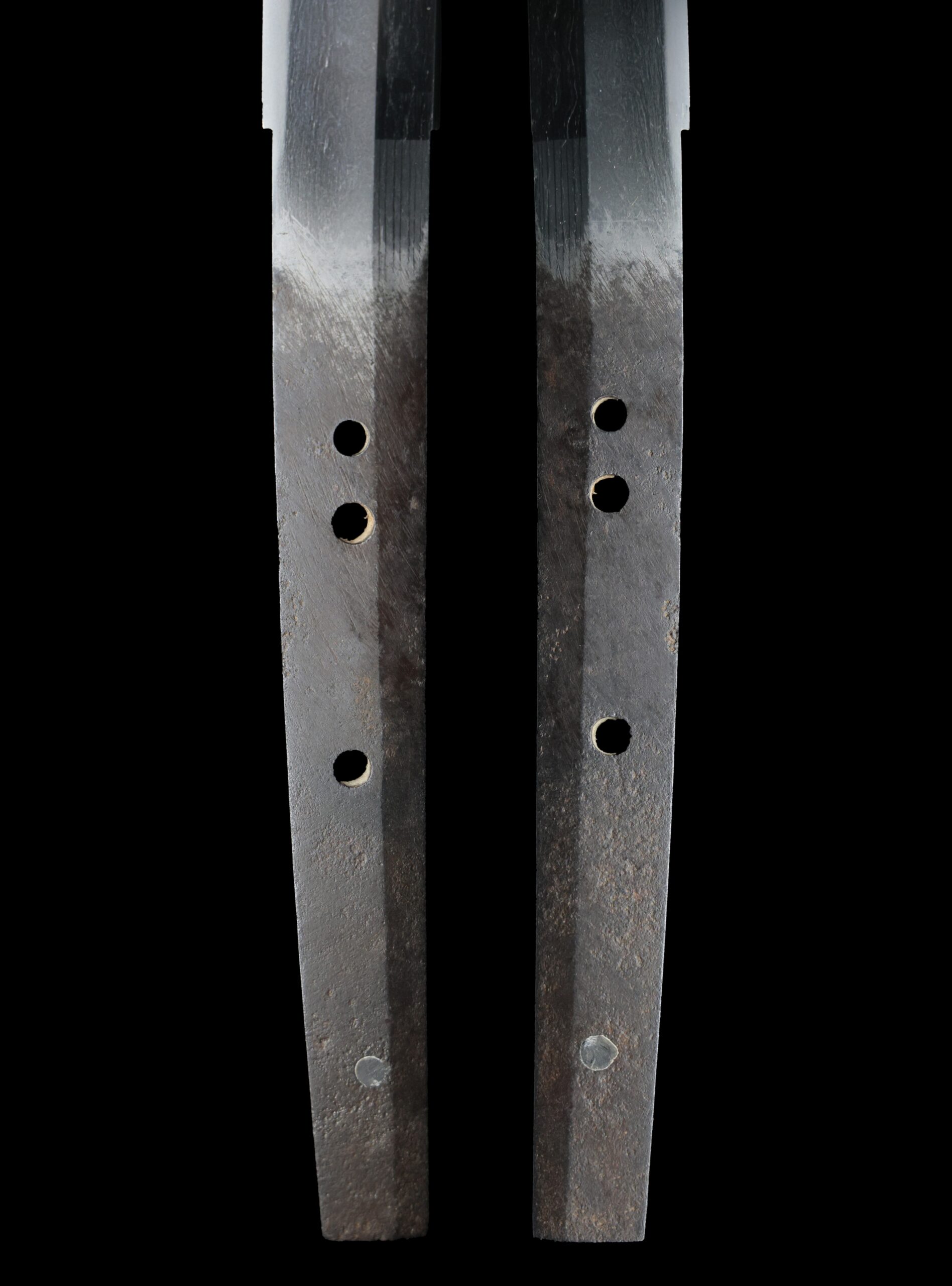
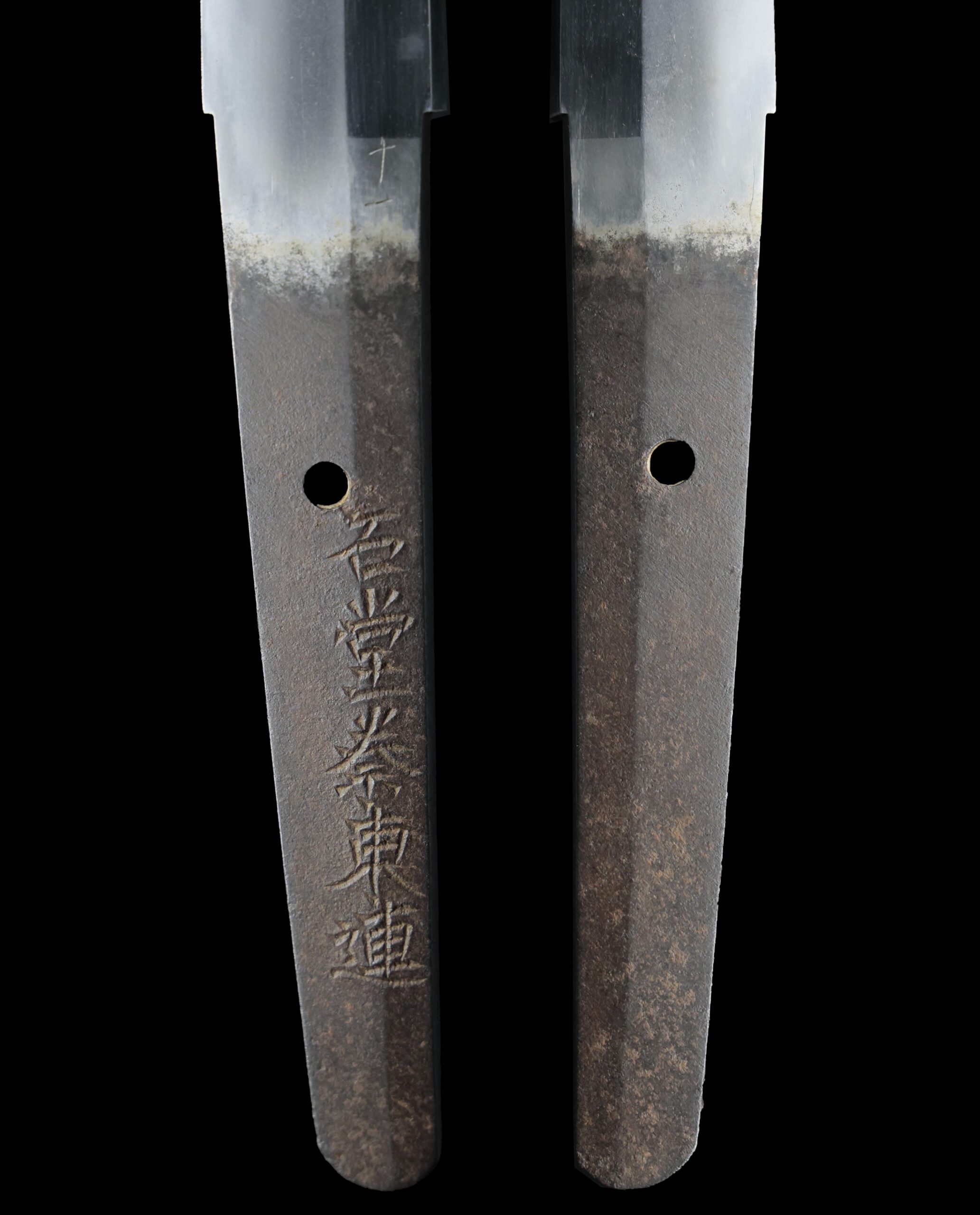
Koshirae: Koshirae is the mounting of the Japanese sword. There are several parts that consist of Koshirae such as Saya (Sabbard), Tsuka (Handle), Tsuba (Handguard).
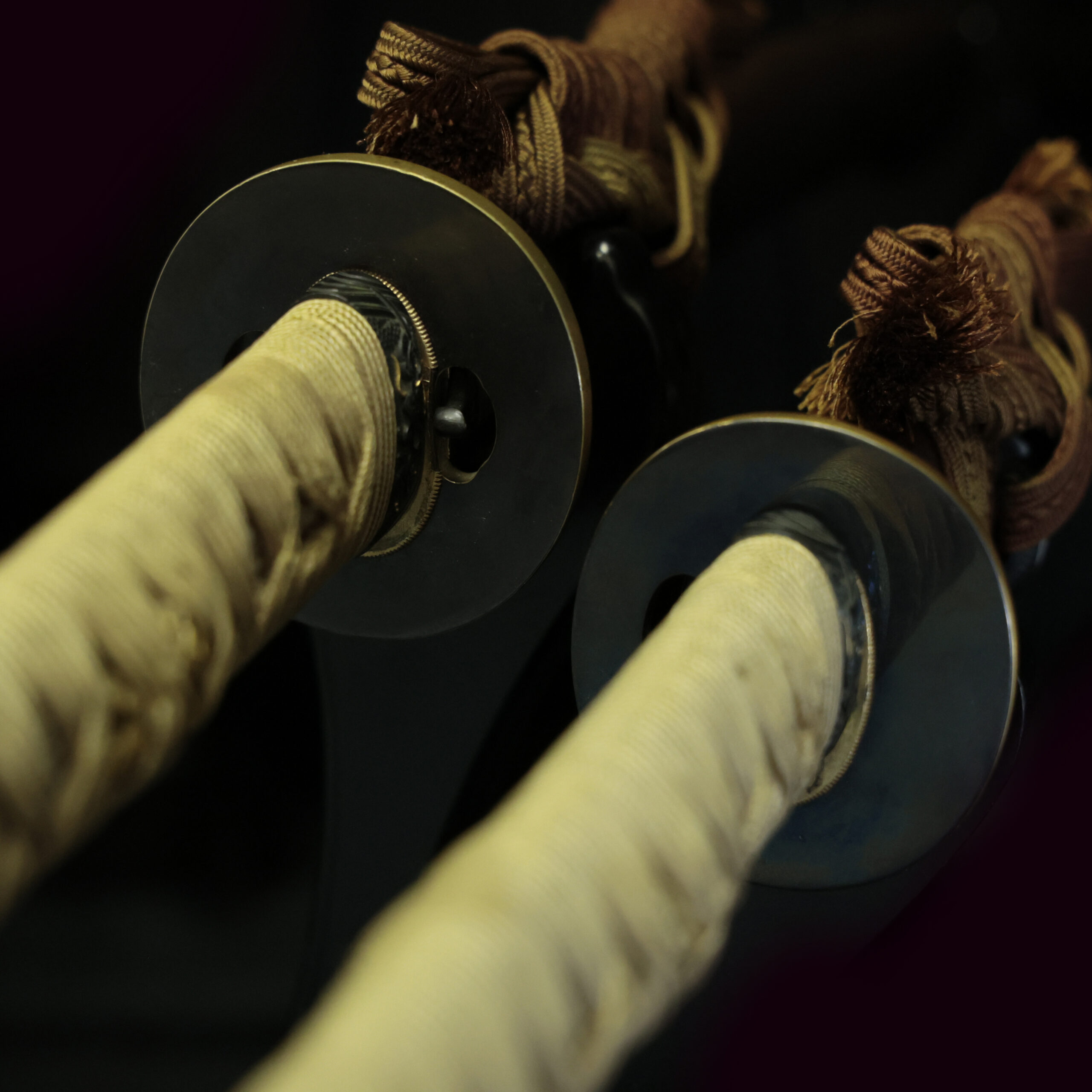
Fuchi-Kashira:A pair of matching sword fittings that cover the upper and bottom parts of its sword hilt.
The theme of this Fuchi Kashira is the Hatou Zu (波涛図), which depicts large undulating and splashing waves.
As waves’ movements continue endlessly, the wave pattern represents eternity, immortality, longevity, birth, etcetera. Also, since tides repeatedly change the shape and terrain of rocks, some people hoped for a strong will by using this motif. People used this pattern wishing for an indomitable spirit to rechallenge time and time without giving up. Thanks to its dynamic design, this motif has been appreciated, especially for men’s Kimono (traditional Japanese costume). It is also said that warlords used wave patterns on their banners and armors, comparing the movement of battle to that of waves coming and going.
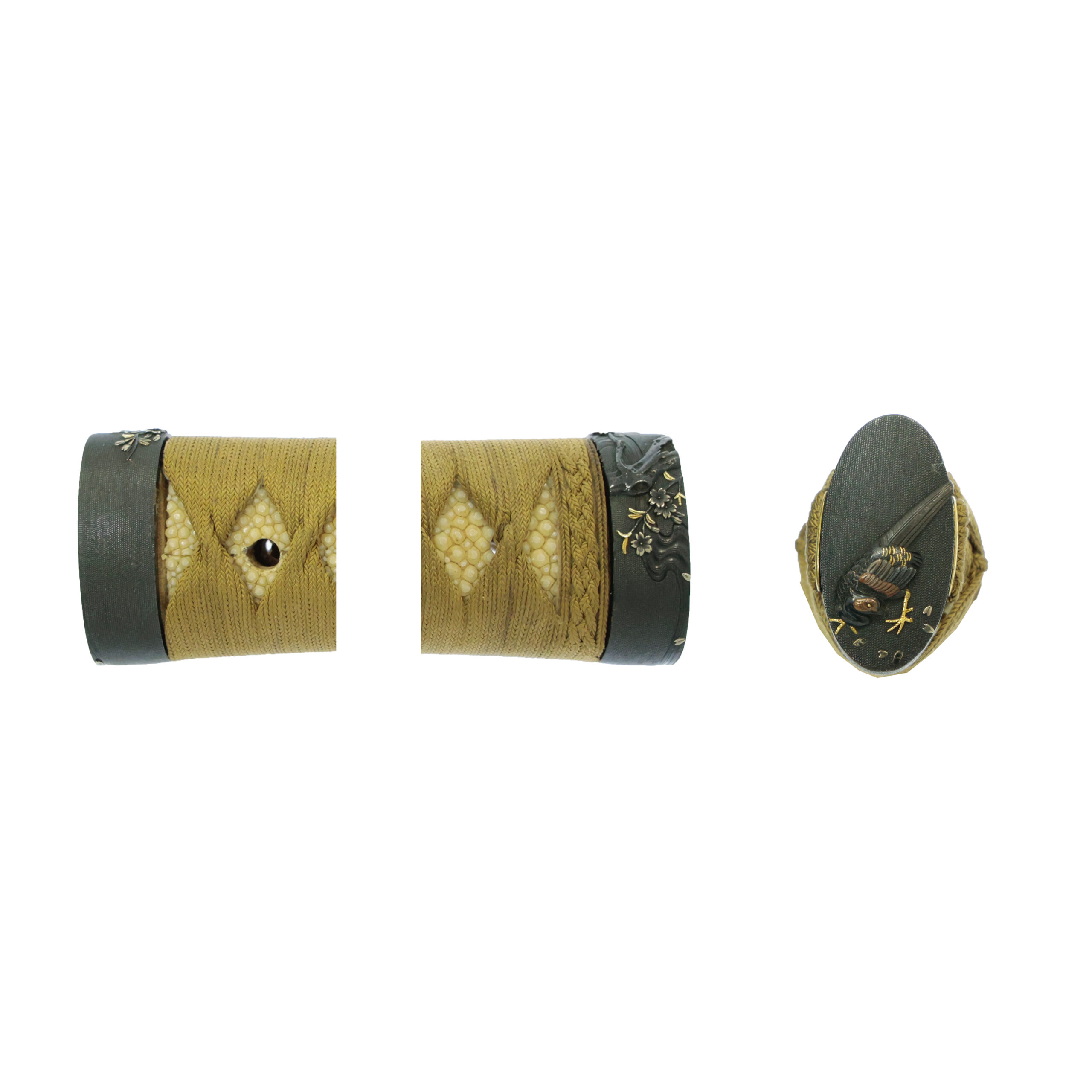
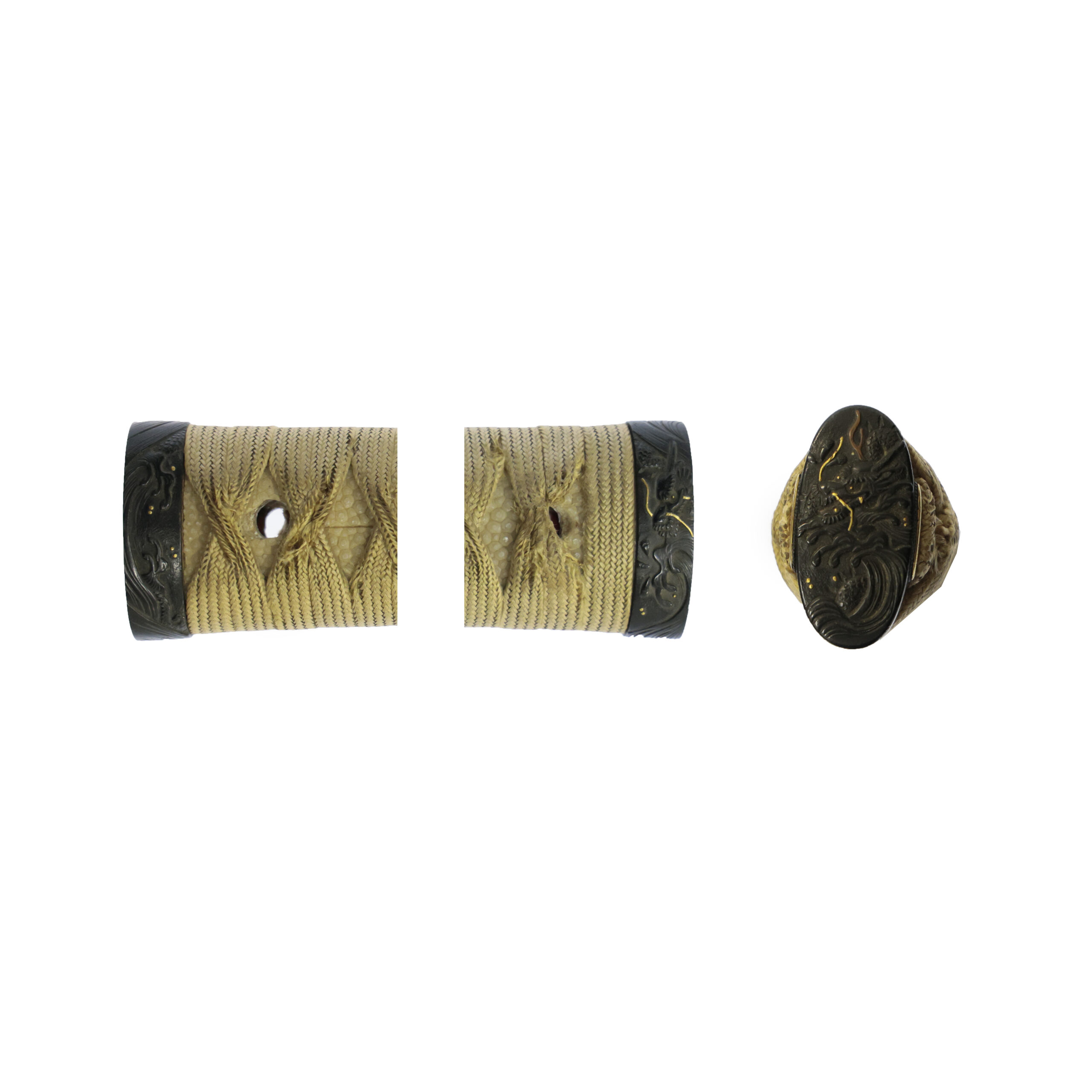
Tsuka and Menuki:Tsuka is the handle of the Japanese sword and Menuki is its decoration.
The theme of the Menuki is Karajishi (唐獅子, lion).
The Shishi (獅子) means a lion in Japanese, and the Karajishi is a lion brought from the continent to Japan in the Toh period (唐, Tang dynasty, 618-907). The Karajishi typically has curly hair for its head, neck, body, and tail, as seen on this work. In Buddhism, the Karajishi is regarded as a symbol of wisdom, and Monju Bosatu (文殊菩薩, Manjushri Bodhisattva) rides lions. According to a theory, the Karajishi is the origin of Komainu (狛犬, stone guardian dogs that exorcize evil spirits). It shows this animal motif has been familiar to Japanese people since ancient times.
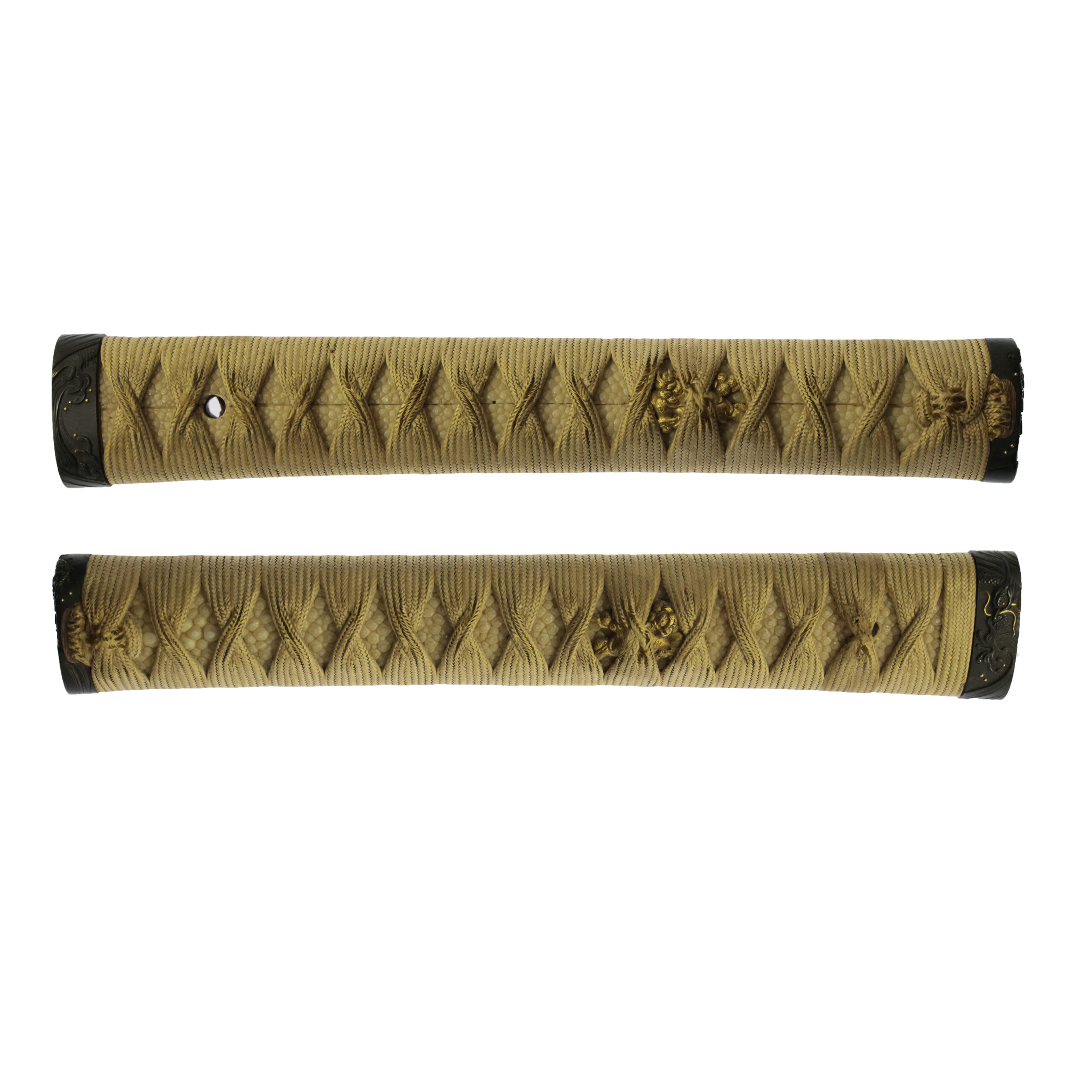
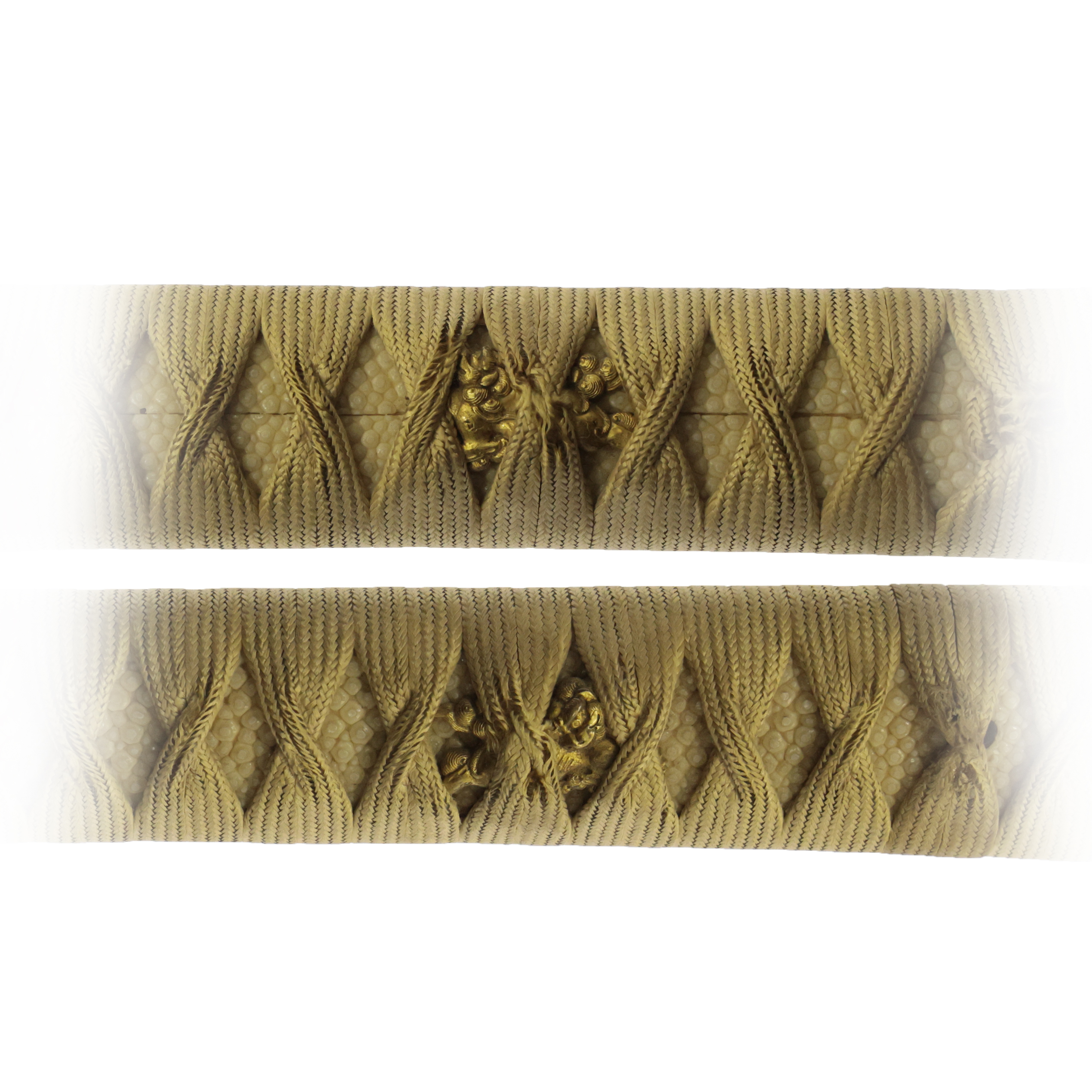
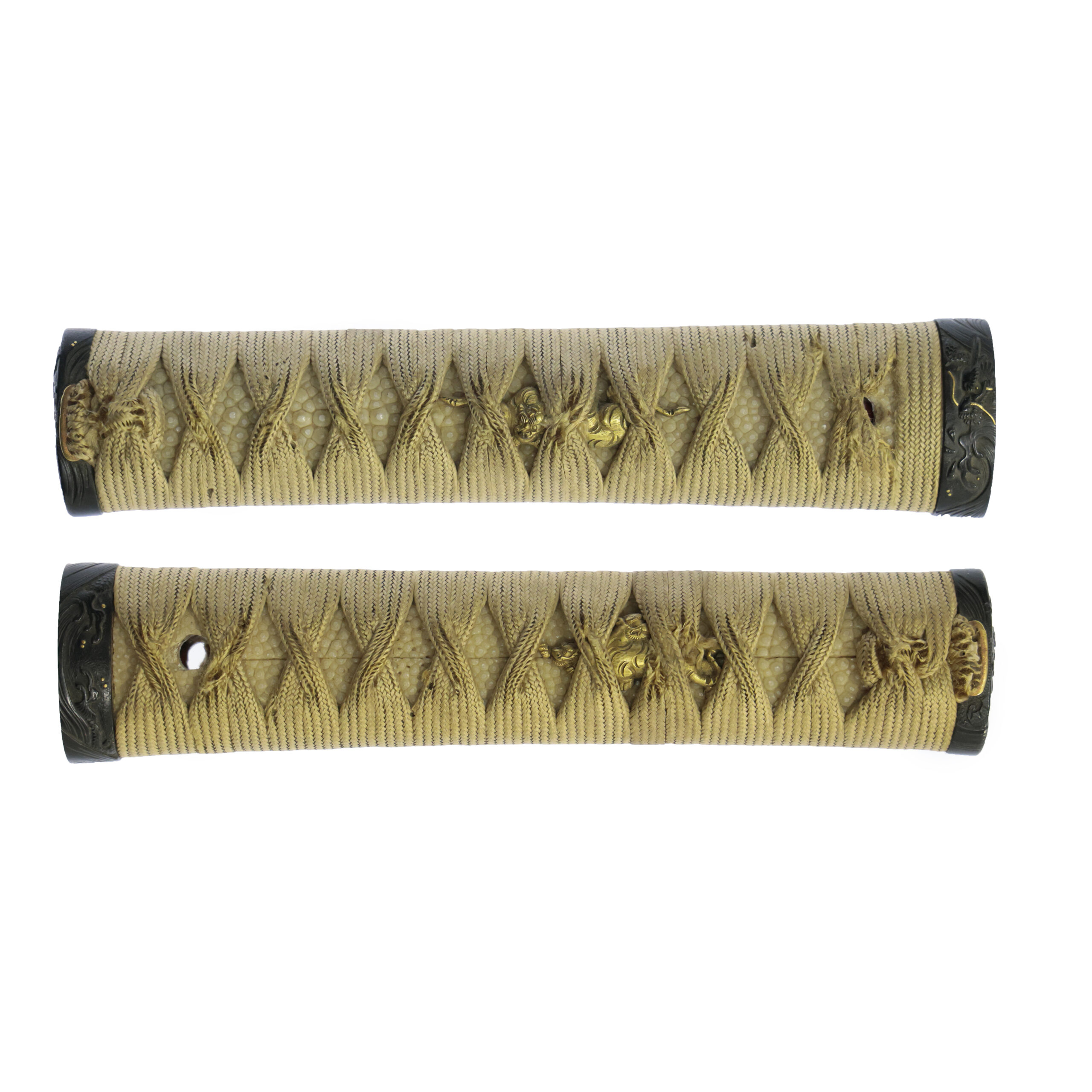
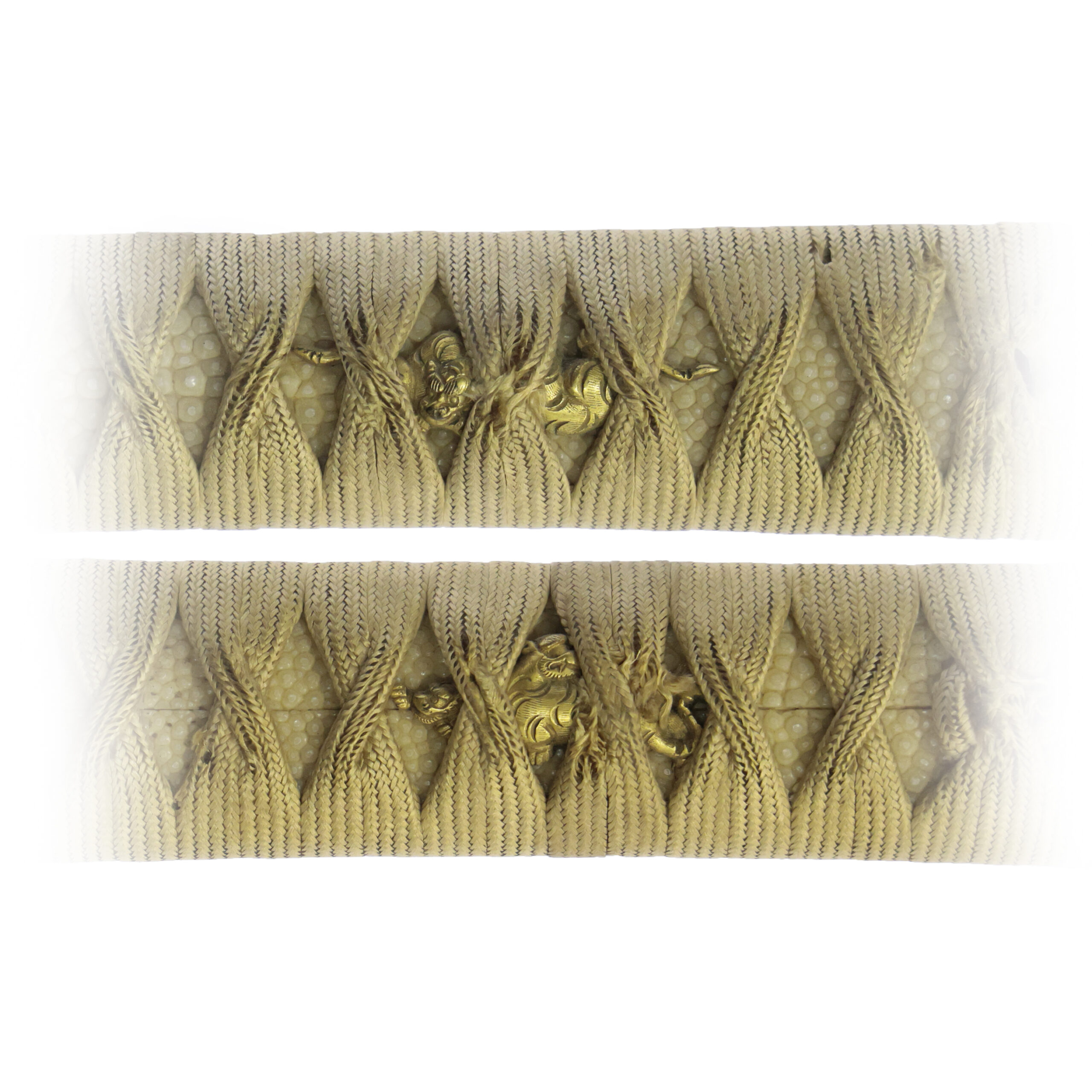
Tsuba and Habaki:Tsuba is the handguard for the Japanese Sword and Habaki is the equipment to make the blade not touch its scabbard inside. It prevents the blade from getting rusty and chipped.
The tsuba is oval-shaped and made of brass. Brass (shinchū in Japanese) is an alloy of copper and zinc, valued for its warm golden color and durability. In traditional Japanese metalwork, brass has often been used for sword fittings and decorative objects, as it combines both practicality and refined beauty.
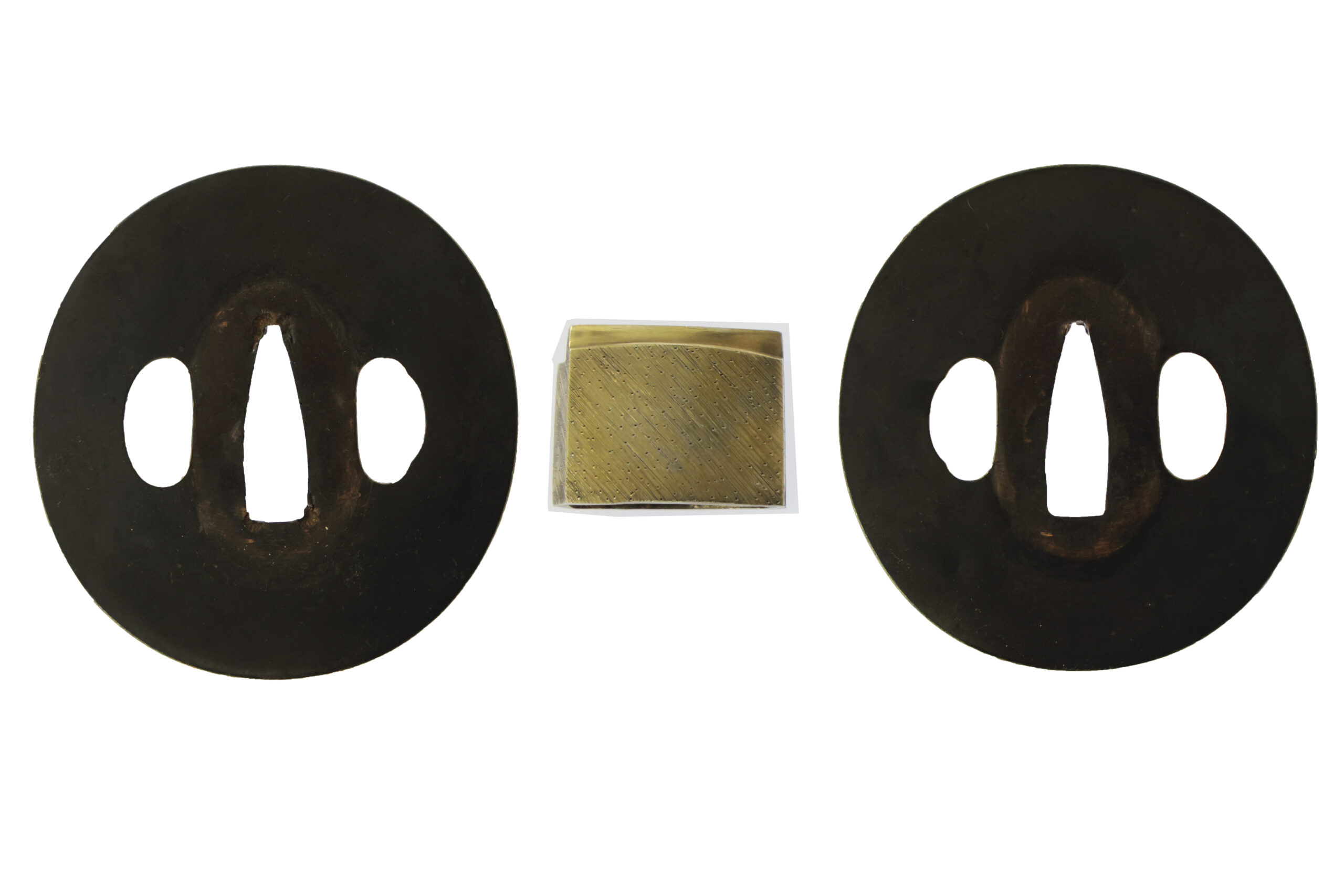
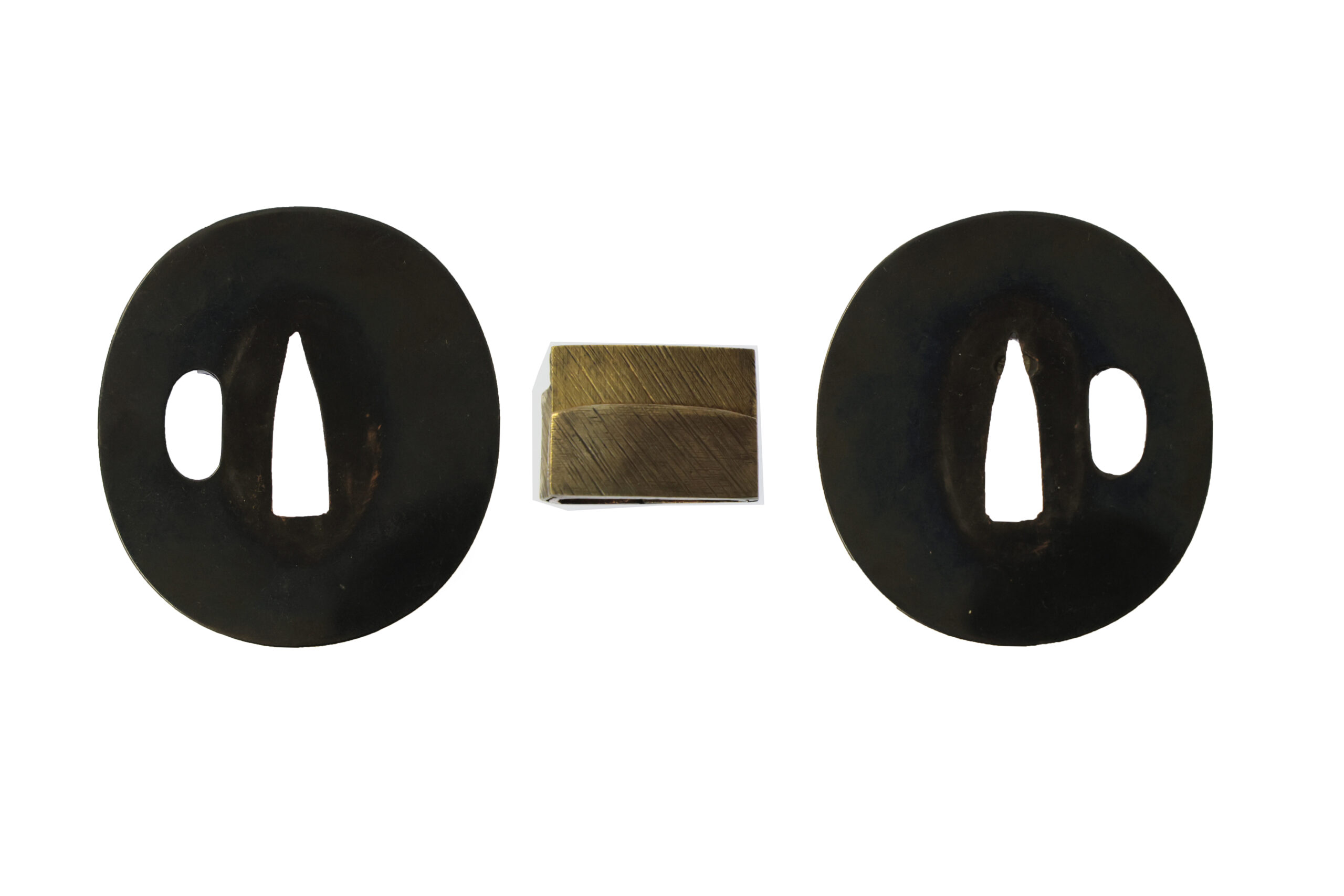
Kozuka:Kozuka is a small knife stored in Kozuka Hitsu(groove of the sheath of the Japanese sword).
The Kozuka, attached to the Wakizashi, is decorated with dragon (龍, Ryū) motif, a powerful symbol in both Chinese and Japanese cultures.
Originally an imaginary creature from ancient Chinese myths, the dragon is believed to bring good fortune and strength. Its body is described as a fusion of nine animals: deer antlers, a camel’s head, demon eyes, a snake’s neck, the belly of a Mizuchi (蛟, a mythical Japanese serpent with a horn and legs), fish scales, falcon claws, tiger palms, and cow ears.
Due to its majestic form, it was seen as the ruler of all creatures. In ancient China, the dragon symbol was strictly controlled, appearing only on the emperor’s robes, with even the number of claws indicating rank. In Japan, however, the dragon motif was widely used without such restrictions, remaining an auspicious symbol of power, protection, and good fortune (吉祥, Kisshō). Today, dragons continue to appear in samurai armor, sword fittings, temples, and traditional art, embodying strength and divine influence.
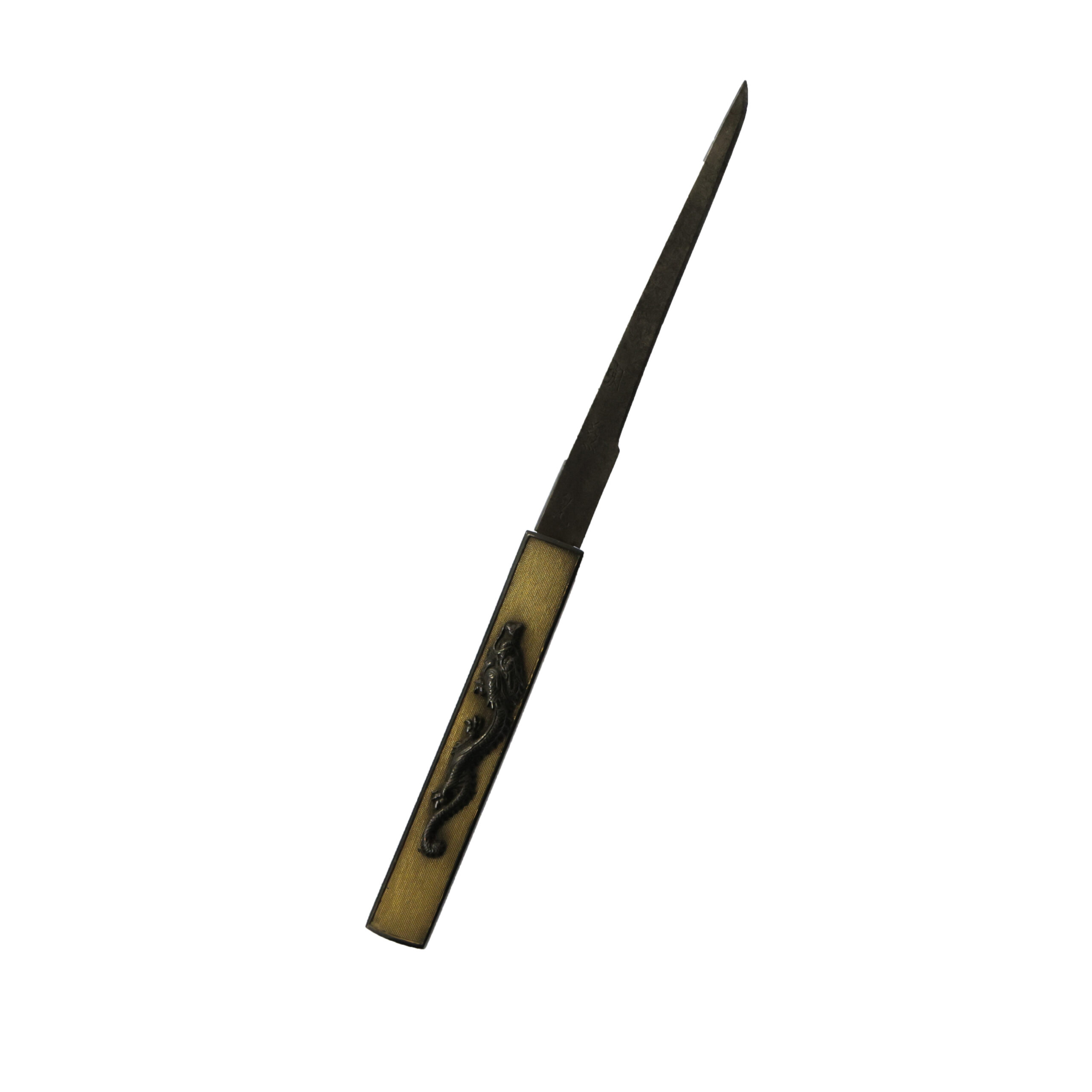
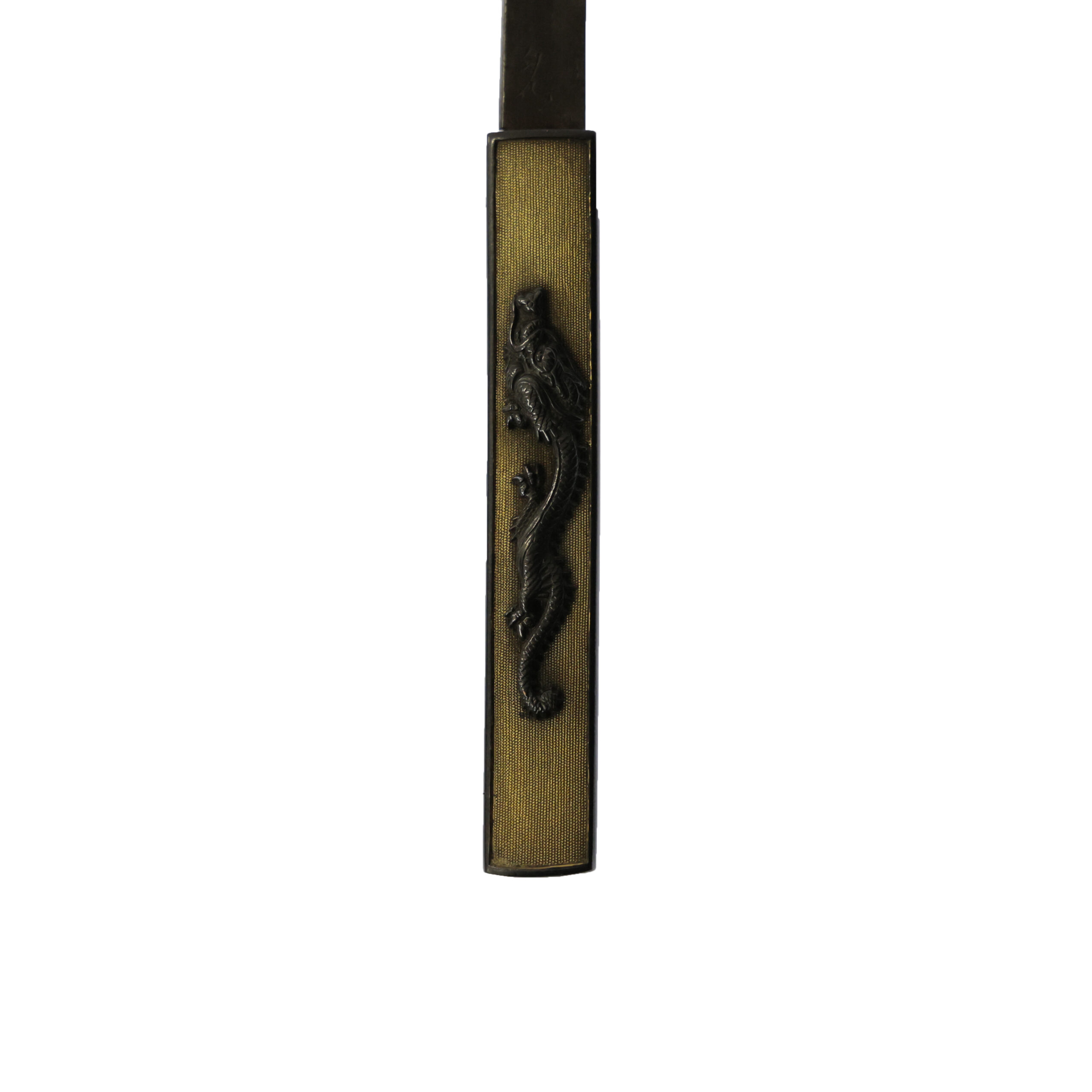
Kougai:Kougai is the equipment for Samurai to arrange or fix his hair style.
This kogai, which accompanies the katana, is also decorated with a dragon motif.
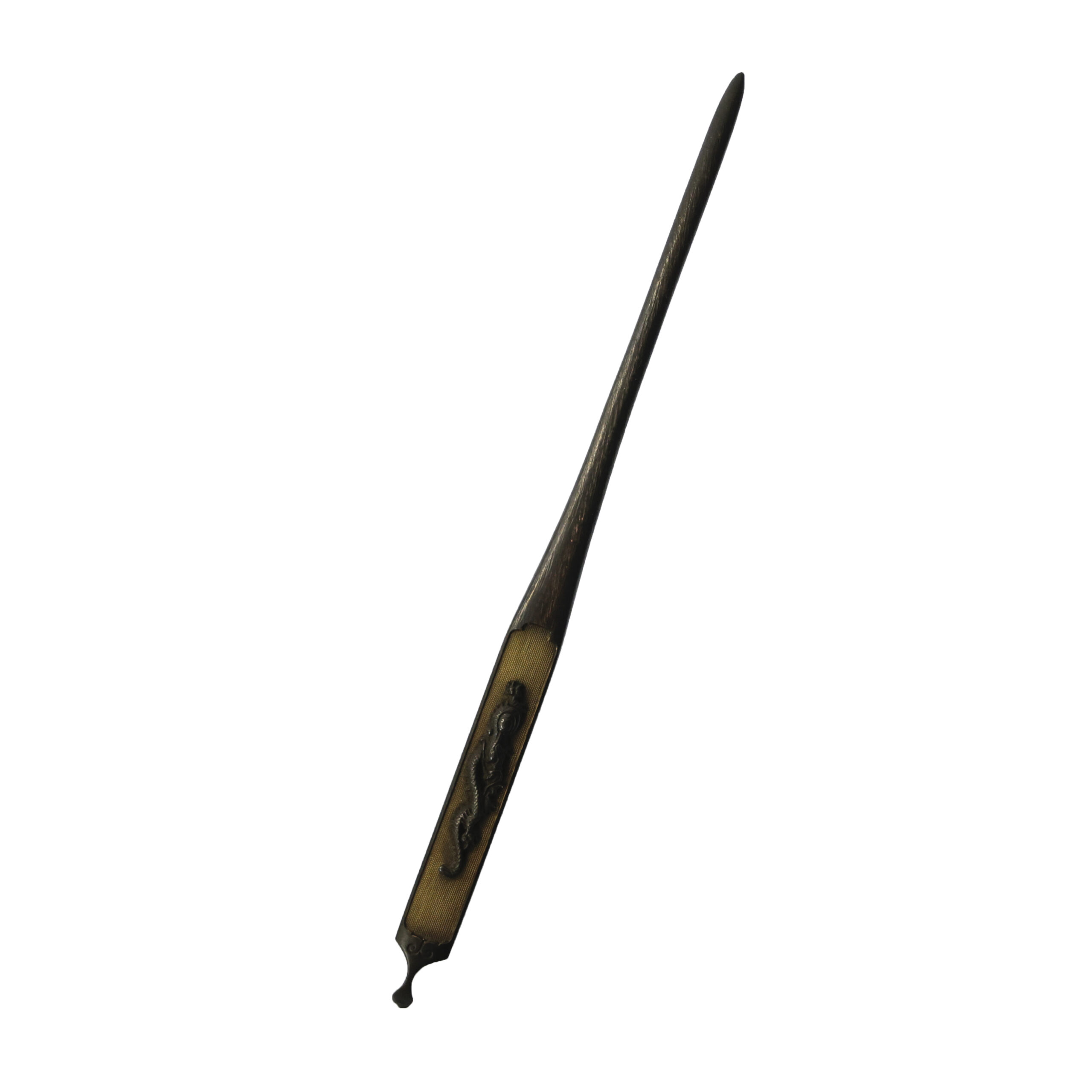
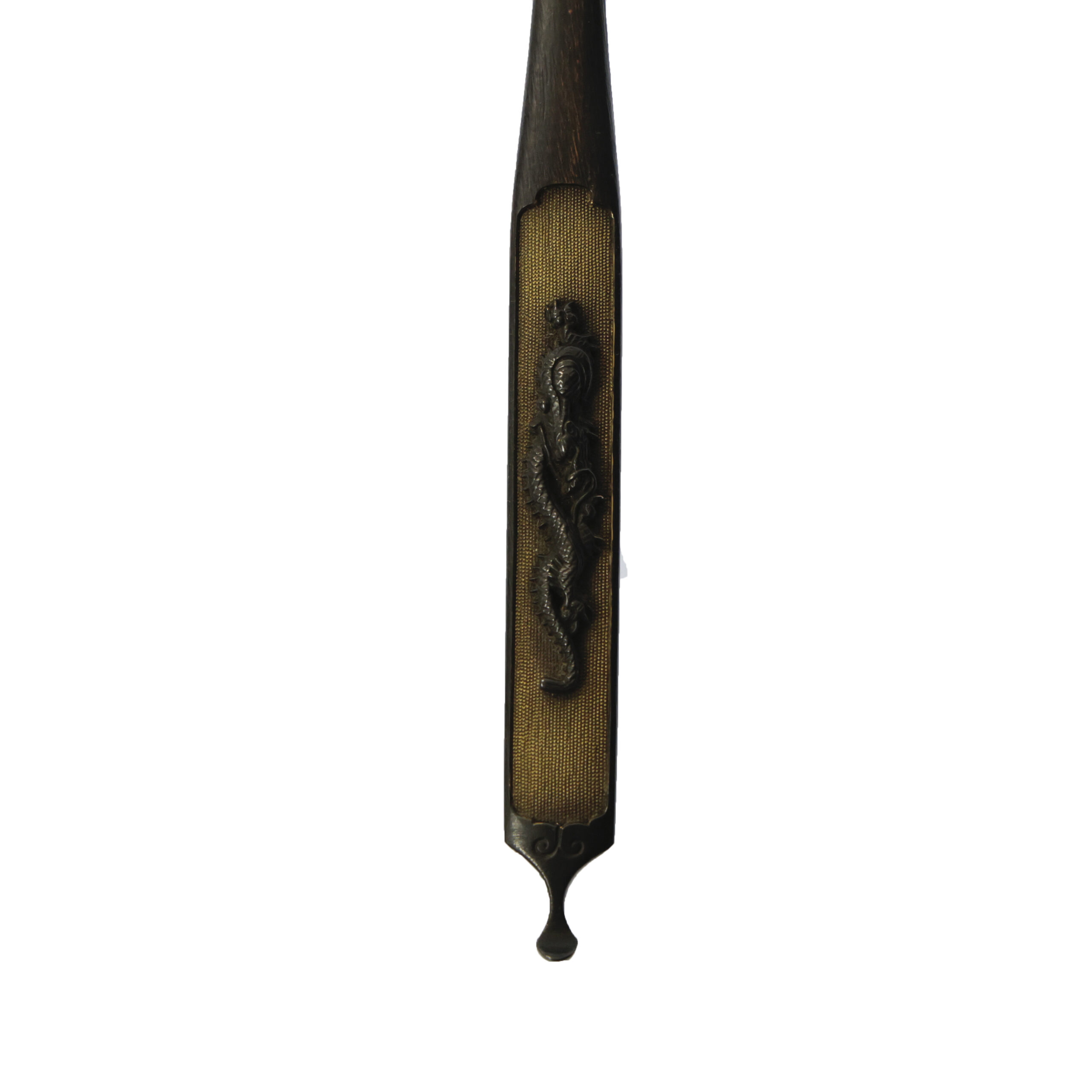
Saya: Saya is the scabbard for the Japanese sword.
Both scabbards (saya) are adorned with a plum blossom crest, a traditional Japanese motif. The plum blossom (梅, ume) is one of the earliest flowers to bloom in spring, symbolizing resilience, renewal, and good fortune. As a crest, it was widely used by samurai families to express strength and elegance.
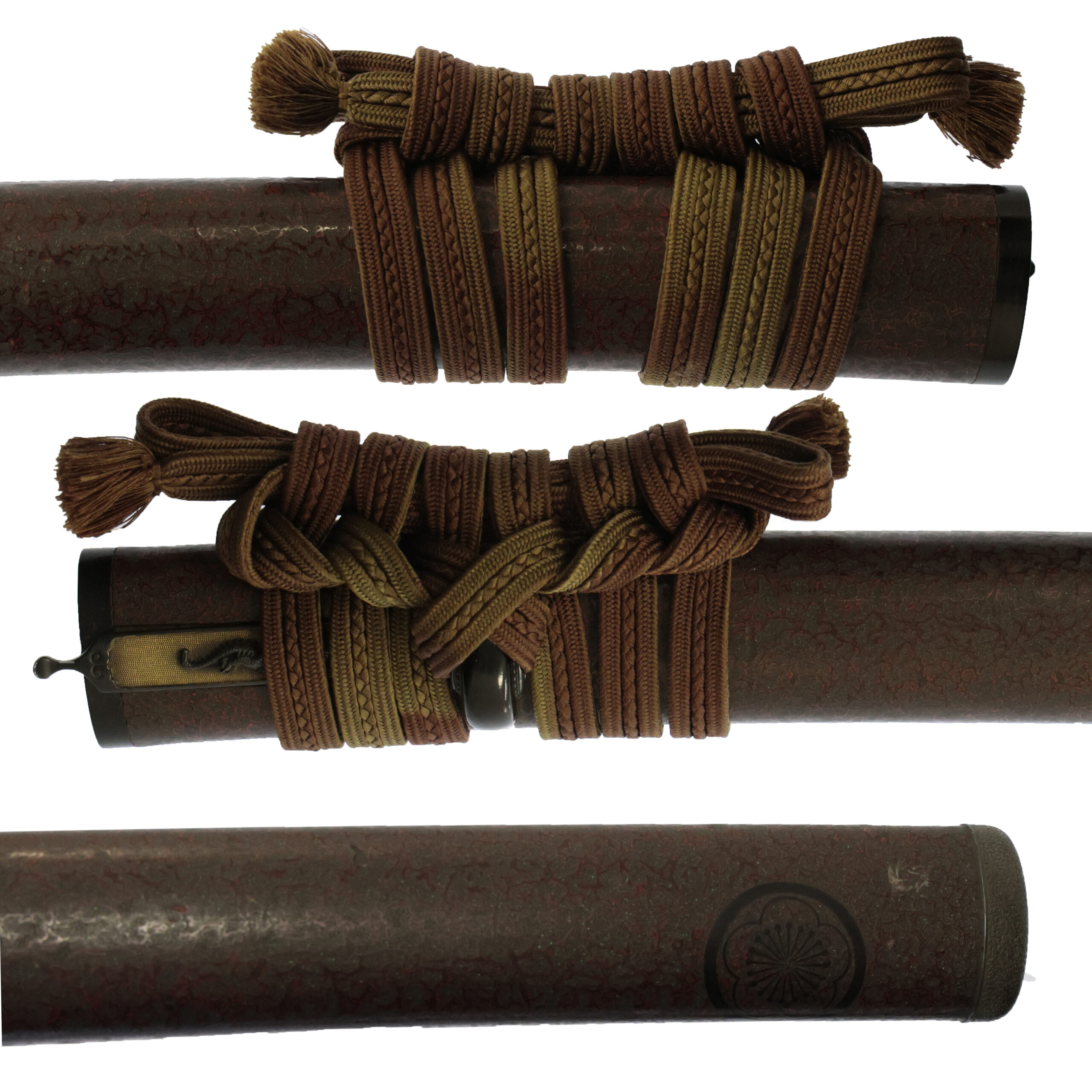
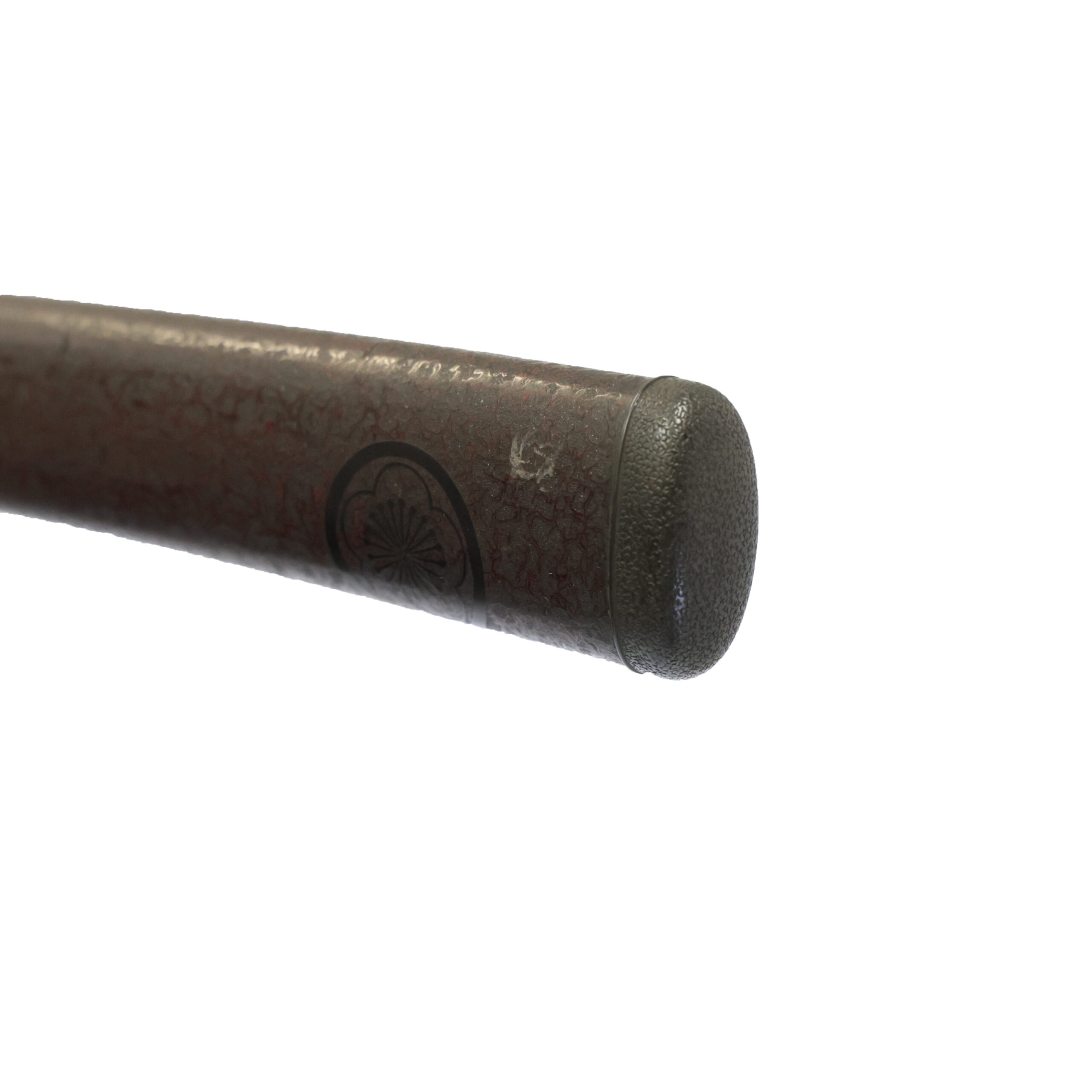

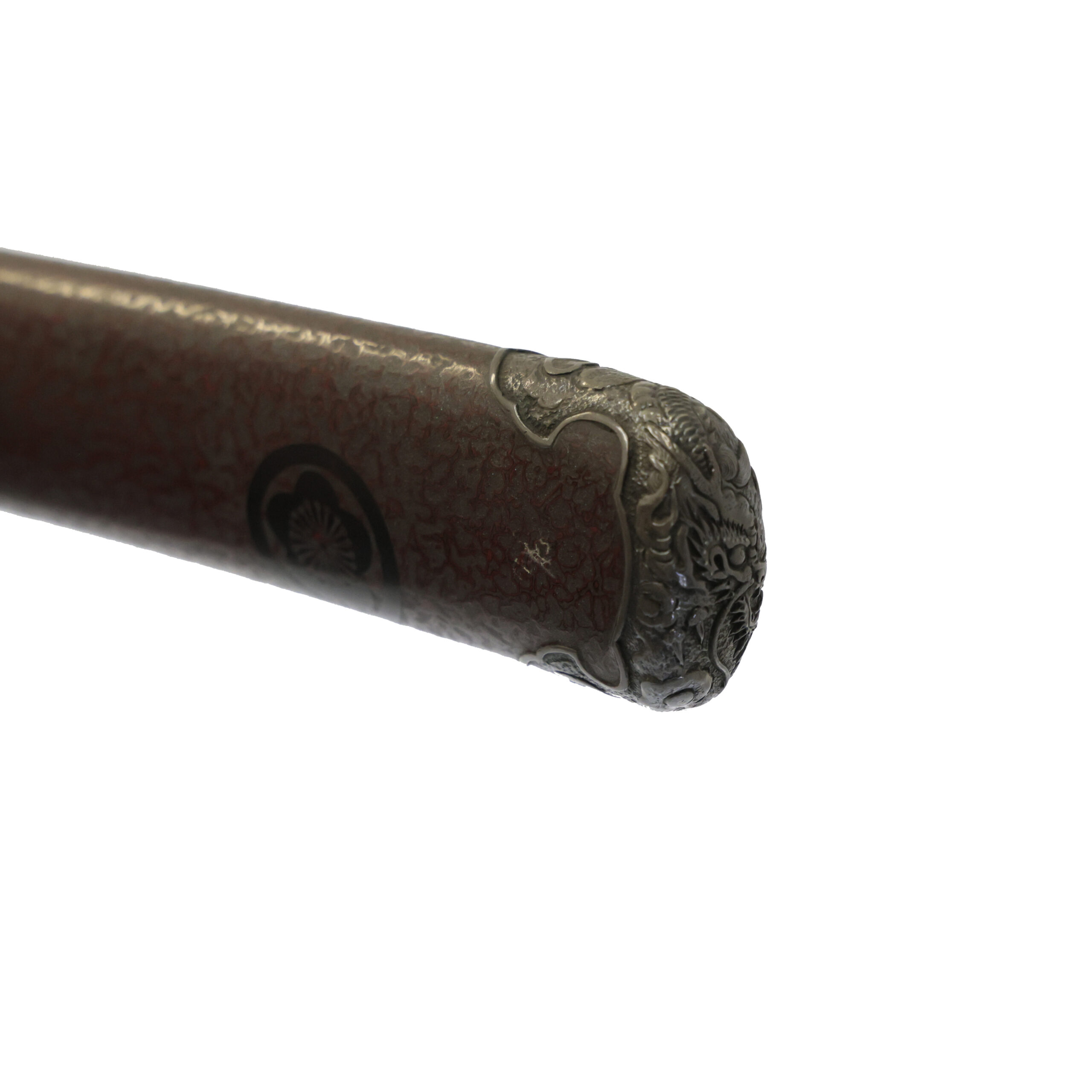
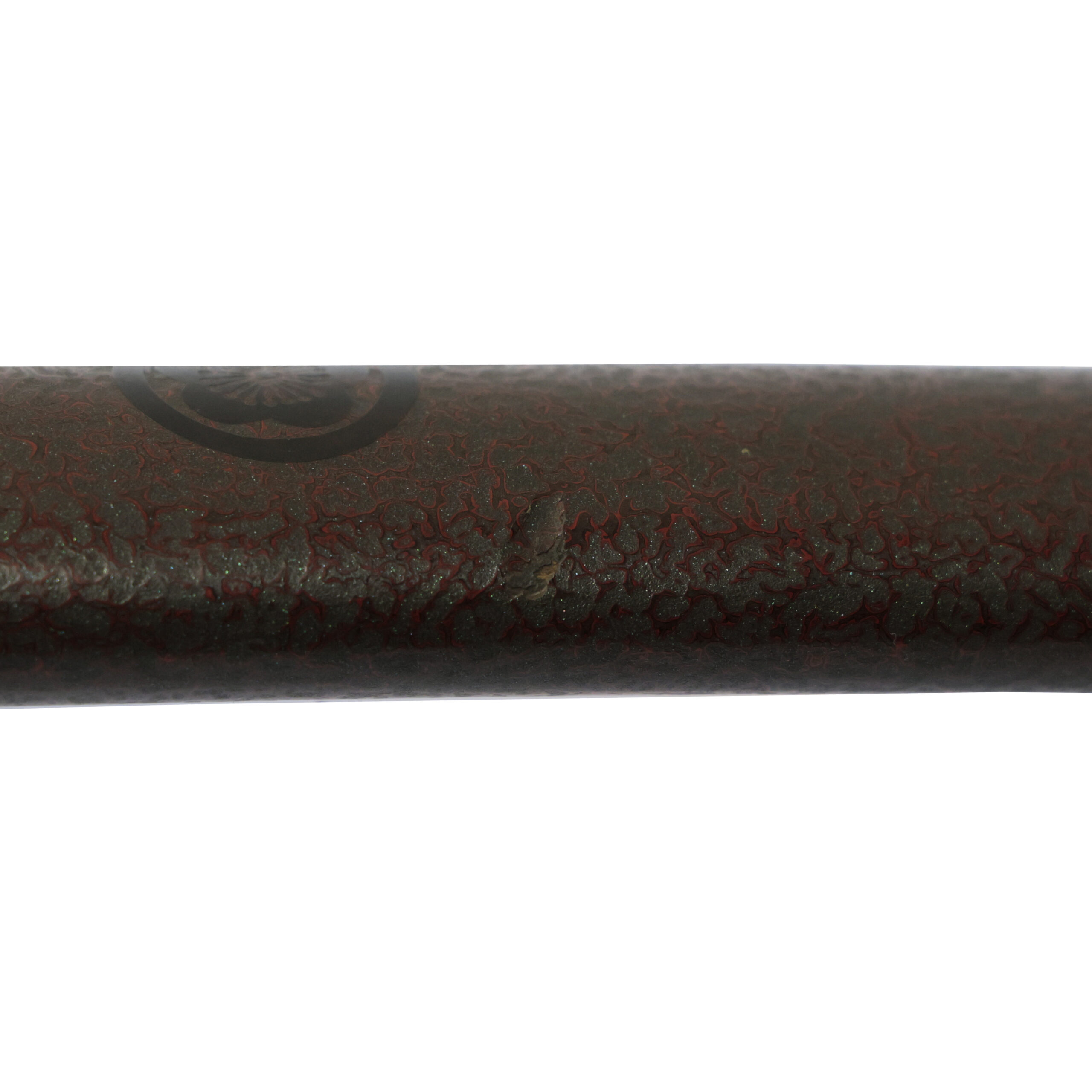
Authentication Paper:NBTHK Tokubetsu Hozon Certificate for the blade (No. 1014597) and NBTHK Hozon Certificate for the Wakizashi (No. 3029652)
NBTHK,, also known as Nihon Bijutsu Touken Hozon Kyokai (the Society for the Preservation of the Japan Art Sword), is one of the oldest Japanese sword appraising organizations in modern-day Japan. They authenticated the Katana blade on November 9th in the 2nd year of the Reiwa (2020) and Wakizashi on August 25th in the 4th year of Reiwa (2022). They appraised the Katana blade as Tokubetsu Hozon Touken and Wakizashi as Hozon Token, blades worth preserving for Japanese society. The purchaser will receive these original certificates as well. We can also translate what is written into English and make a PDF file for your record if you request.
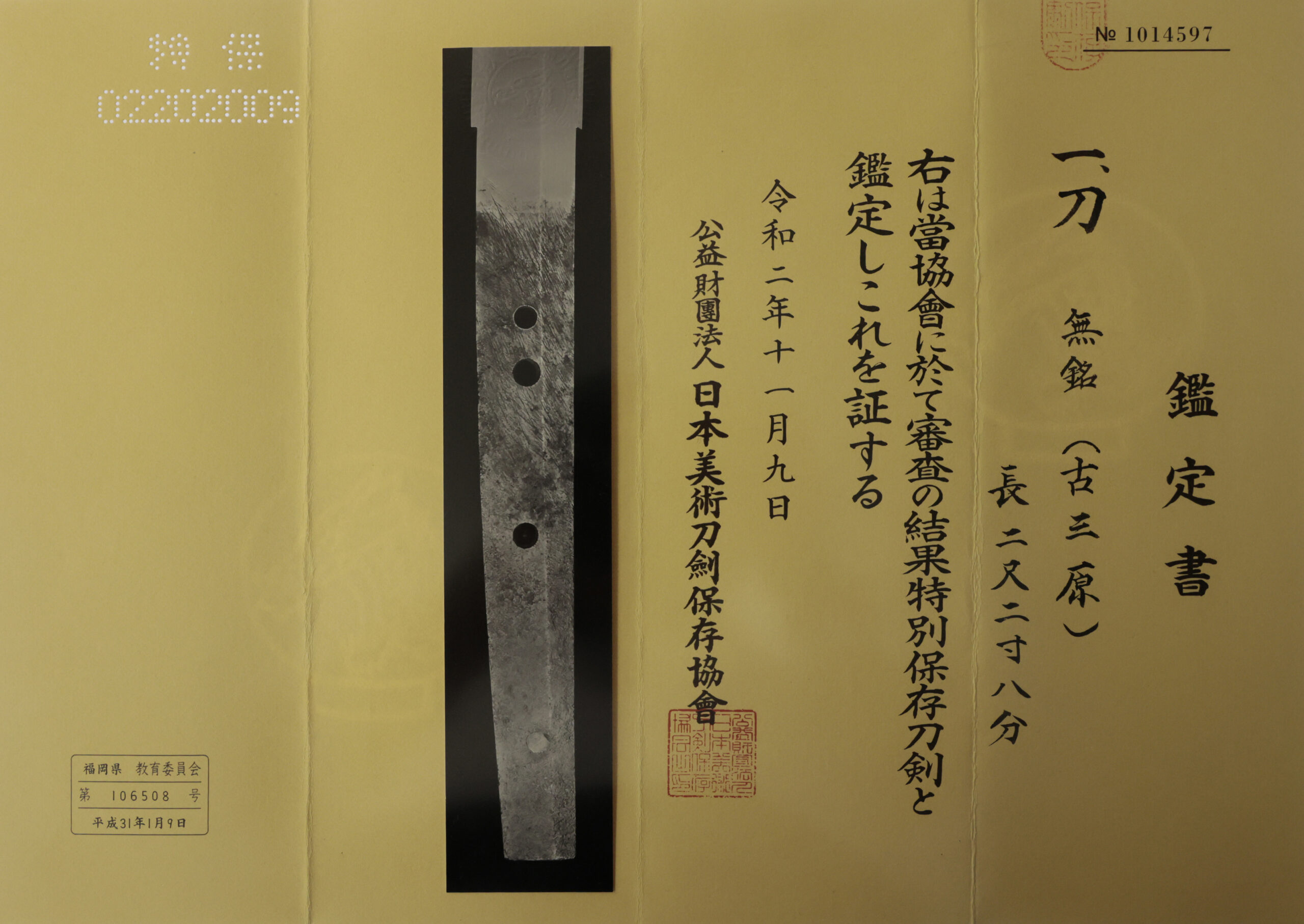
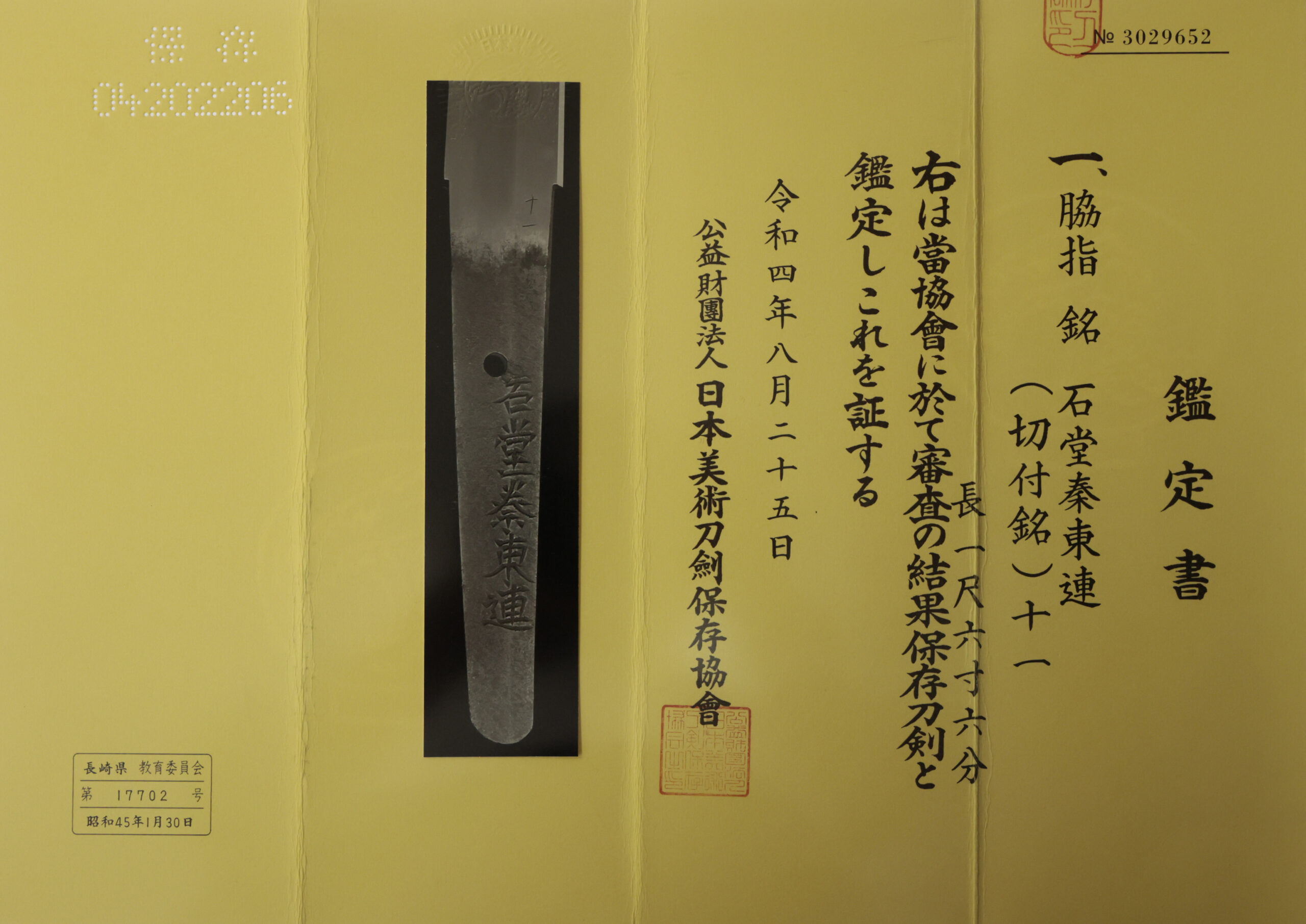
Registration Number : Fukuoka 106508-Nagasaki 17702
The Board of Education in Fukuoka prefecture issued a registration paper for the Katana blade and Nagasaki prefecture issued a registration paper for the Wakizashi sword . It is called Jyu Token Rui Torokusho(銃刀剣類登録証). Bunkacho(The Agency for Cultural Affairs) acknowledges a Japanese sword with this paper as a work of art.
The sword needs to be traditionally hand-forged and made of Tamahagane carbon steel to be registered in the system. With this paper, its owner in Japan can legally own an authentic Japanese sword. Based on this registration number, we will apply for its export permit.
This paper will need to be returned to the board of education when the sword is being shipped abroad, but you can receive a copy of it. An English translation of this registration paper is available on request.
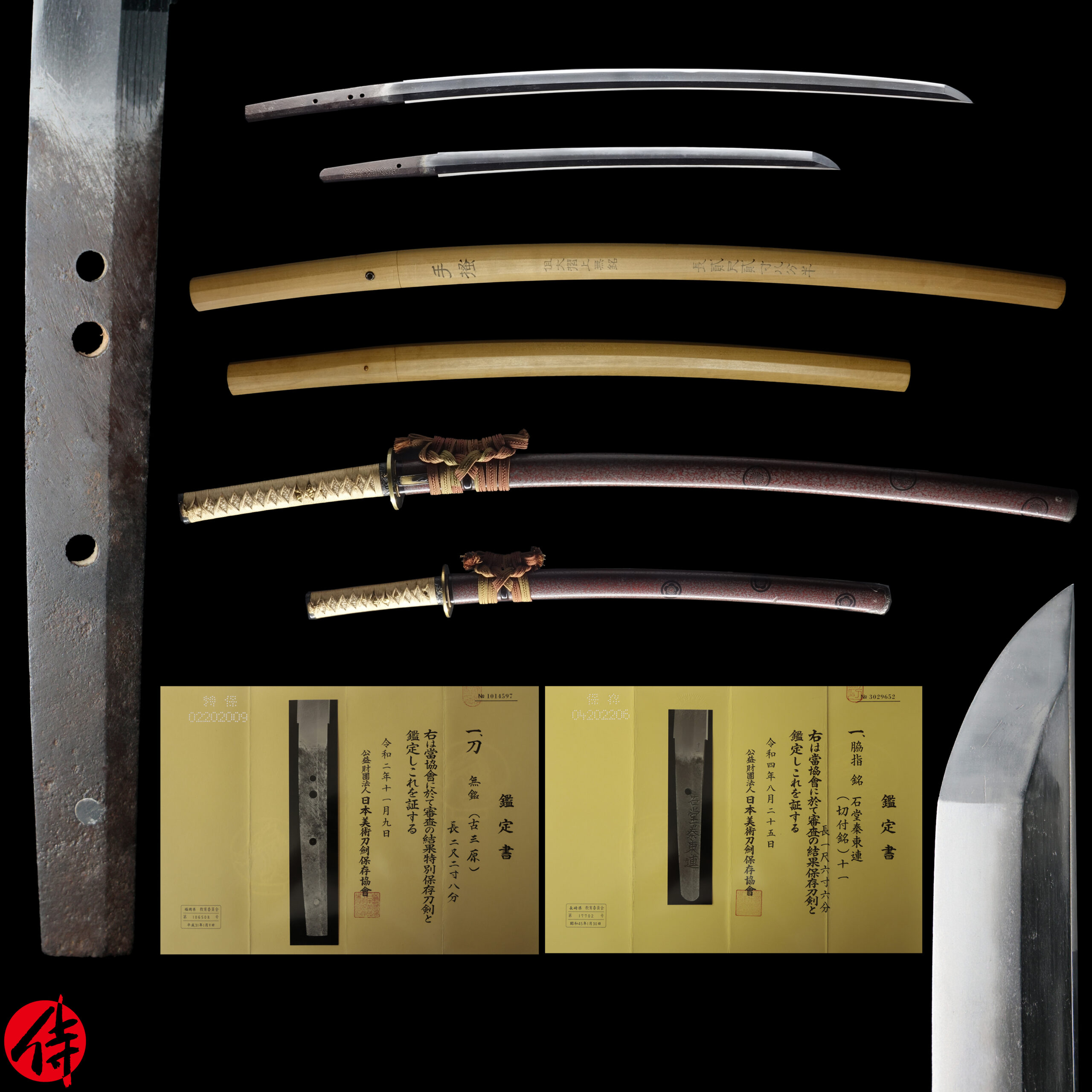
—————————————————————–
【About us】
Samurai Museum is located in Tokyo, Japan, exhibiting antique artifacts related to the Samurai history. Samurai Museum Shop is the place for those who are interested in Japanese culture and craftsmanship. We deal with antique Samurai swords/armor, traditional crafts made in Japan and so on.
【Japanese Sword& Export Process】
The Japanese swords we deal with are hand-forged edged swords made in Japan. It was made from the traditional carbon steel called TAMAHAGANE(玉鋼). Samurai Museum is familiar with the proper legal procedure for an antique/ authentic Japanese sword to be exported from Japan. We have sent more than 700 Japanese swords for the past few years (~2024) to amazing owners who appreciate its historical value.
Each Japanese sword is registered under the Agency for Cultural Affairs and the Board of Education in Japan. They issue a registration paper for each Japanese sword for its owner in Japan to legally possess it. The Japanese sword with its registration paper means it was traditionally hand-forged in Japan.
To legally export the sword from Japan to other countries, we will have to apply for its permit to the Agency for Cultural Affairs(Bunkacho) and return the original registration paper to the Board of Education. It normally takes around 2-4 weeks to receive this permit after submitting required documents. And we would like you to expect at least 1-1.5 months for your order to arrive at your given address after you ordered. For more detailed info, please click here.
It is allowed for residents in Japan to own authentic Japanese swords without a special license as long as they come with registration papers. Please feel free to contact us if you are a resident of Japan, whether temporarily or permanently. We will also assist you when you leave Japan and need to obtain the export permit.
【Payment Method】
We accept payment through Stripe (Credit card), PayPal, Apple Pay or ChromePay, all of which are secure payment methods. Also, you don’t need to make an account on Stripe for the checkout. If you prefer other payment method, please contact us. After confirming your payment, we will apply for an export permit. You may either pay in JPY, USD, AUD, CAD,EUR CHF or GBP. The price is set in Japanese Yen. Prices in other currencies are automatically calculated based on the latest exchange rate.

* If the amount is above 1 million JPY, Stripe or wire transfer will be the only options for payment.
【Shipping】
We have shipped authentic Japanese swords to the USA, Canada, Mexico, Germany , Belgium, France, Finland, Hong Kong, Australia. If you don’t live in these countries and like to order, please contact us first before making a purchase. We offer Free International Shipping as long as we can send antique Japanese swords by EMS.
We normally ship by EMS(Express Mail Service) provided by Japan Post. We will send you a tracking number for your order as soon as we hand it to the post office. We will put 100 % insurance on the shipping document without any extra charge. Based on the total amount, there might be a duty tax or other fee for you to pay, depending on the countries. We use package cushioning to protect the item and put it in a PVC pipe, which is one of the most secure packages because of its durability.
It will normally takes 5-14 days for the item to arrive at your given address after we dispatch it. Time of delivery is estimated as accurately as possible by the carrier but does not take into account any delays beyond our control such as by inclement weather, post office holiday seasons.
* If you live in Australia and like to purchase an authentic Japanese sword, please click here to know the detail.
* If you live in the UK and like to purchase an authentic Japanese sword, please contact us first and click here to know the detail.

【Review】
Here is one of the reviews we received from a customer who purchased an authentic Japanese sword from us. For more reviews, please click here.
“My experience overall with the whole process was wonderful. I had many questions about the history and process to purchase these treasures. All my questions were answered very timely and complete. The staff is very knowledgeable and very well versed if any questions do arise.”
【How to make sure the condition】
Please keep in mind that what you are going to purchase is an antique item. We uploaded high resolution photos for you to check its condition thoroughly. If you like to see more photos with different angles, please feel free to contact us. We will be happy to send them to you so that you can make informed decision. It is essential for us to know that you are happy with your choice of a sword. and we are prepared to use the best of our ability to serve you.
【How To Contact Us】
Please contact us through email, Facebook Messenger or Live Chat if you have any questions. You can find each icon on the right side of the website. Please click one of them to reach us. We will reply to you within 1-2 business days.
【The Art of Nihonto (Japanese Sword)】
Samurai’s history is a profound, eloquent legacy of ancient Japanese warriors in which millions of people worldwide are being fascinated. If you like to find out the art of Nihonto, please click here.
【A Guide to Japanese Sword Maintenance】
After acquiring an genuine Japanese sword, it is also important to know how to take good care of it. Here is the special video for you. Mr. Paul Martin, Japanese sword expert, shows you how to give proper maintenance to your sword. By mastering how to clean the Japanese sword, its aesthetic beauty will last forever.
When you purchase a Japanese sword from us, you can get a Free Japanese sword maintenance kit. It comes with four tools(Choji Oil, Uchiko Whetstone Powder, Peg remover, Oil Applicator). By watching the video instruction above , you can enjoy learning how to maintain your Japanese sword while appreciating it. If you have any difficulty assembling the sword or cleaning the blade, you can feel free to contact us.
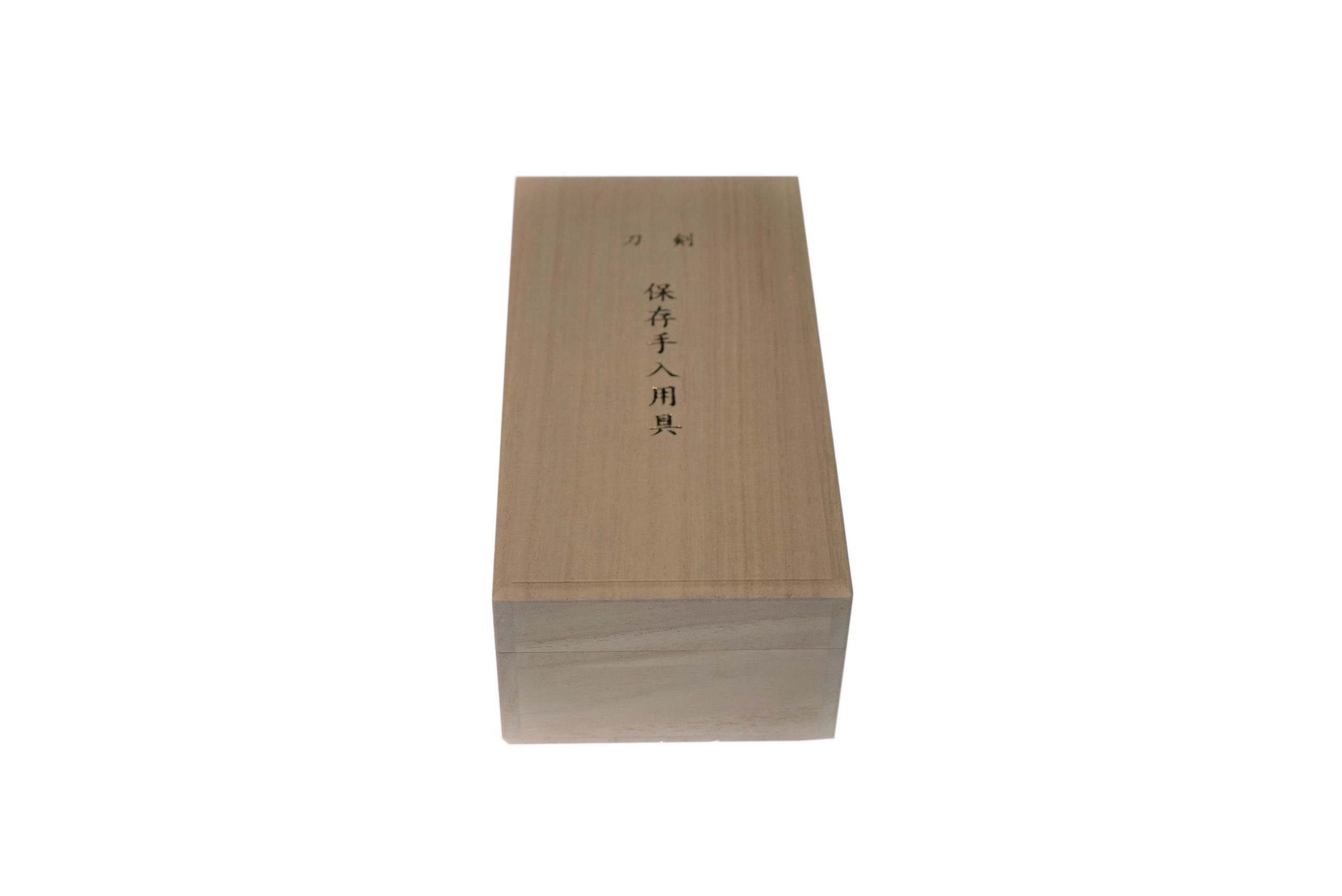
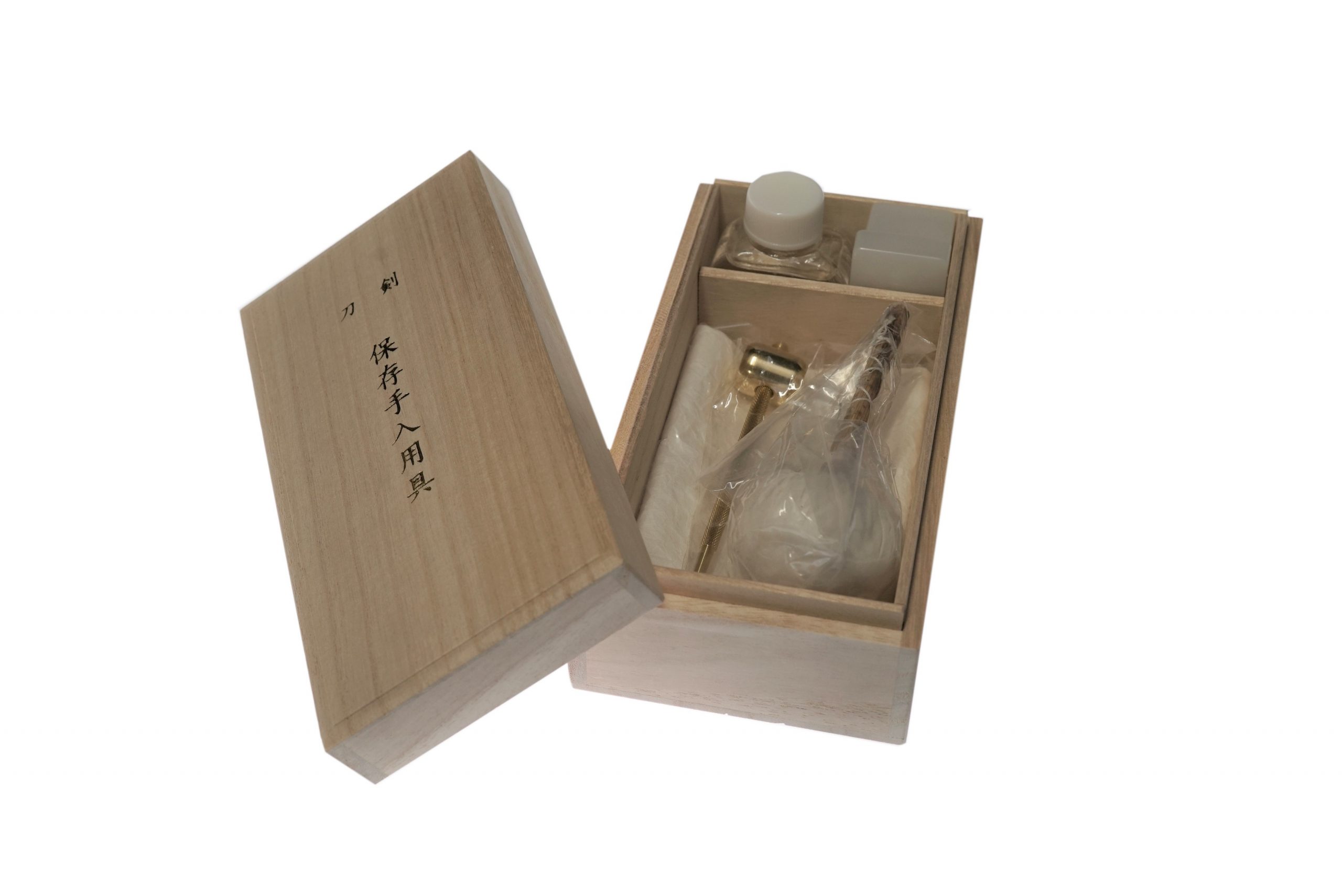
MORE ANTIQUE JAPANESE SWORD FOR SALE
SWORDS WITHOUT CERTIFICATES FOR SALE
LEARN JAPANESE SWORD TERMINOLOGY
Thank you for reading all the information on the page. If you have any difficulty choosing the right Japanese sword for you, we will be more than happy to help you find the one that speaks to you the most. Please feel free to contact us.
